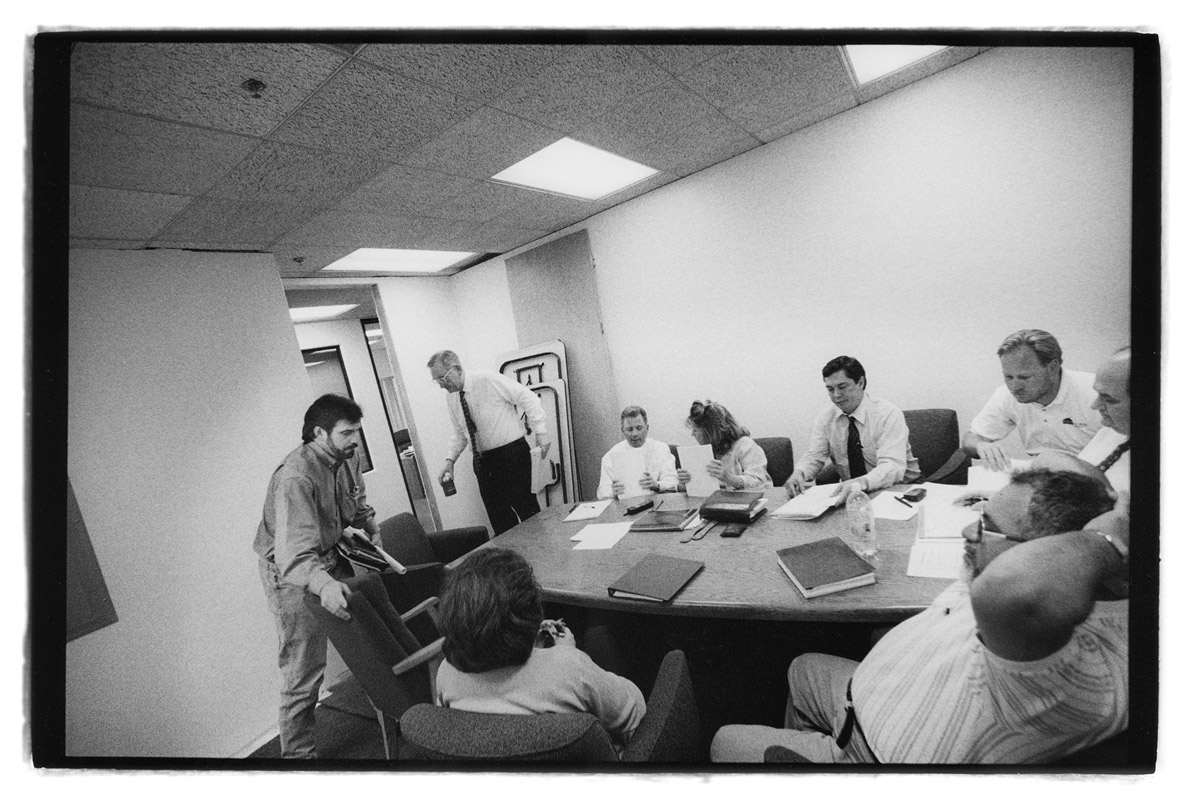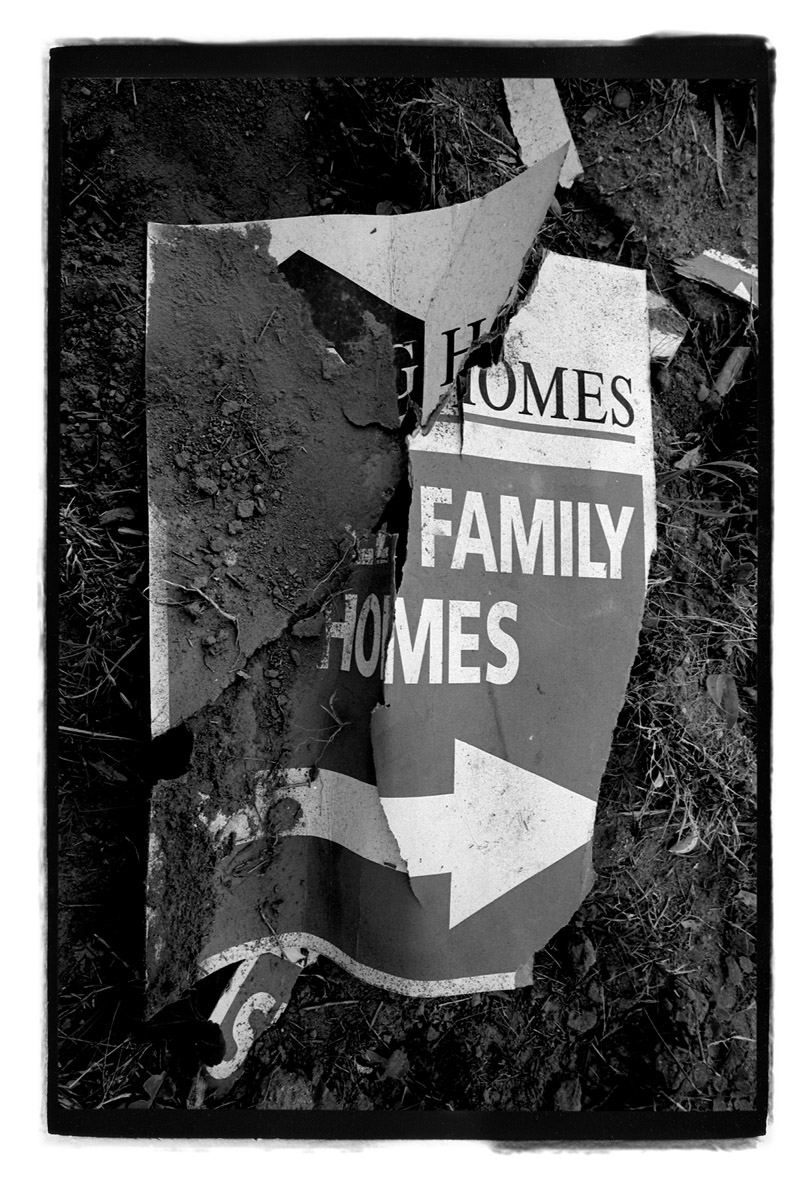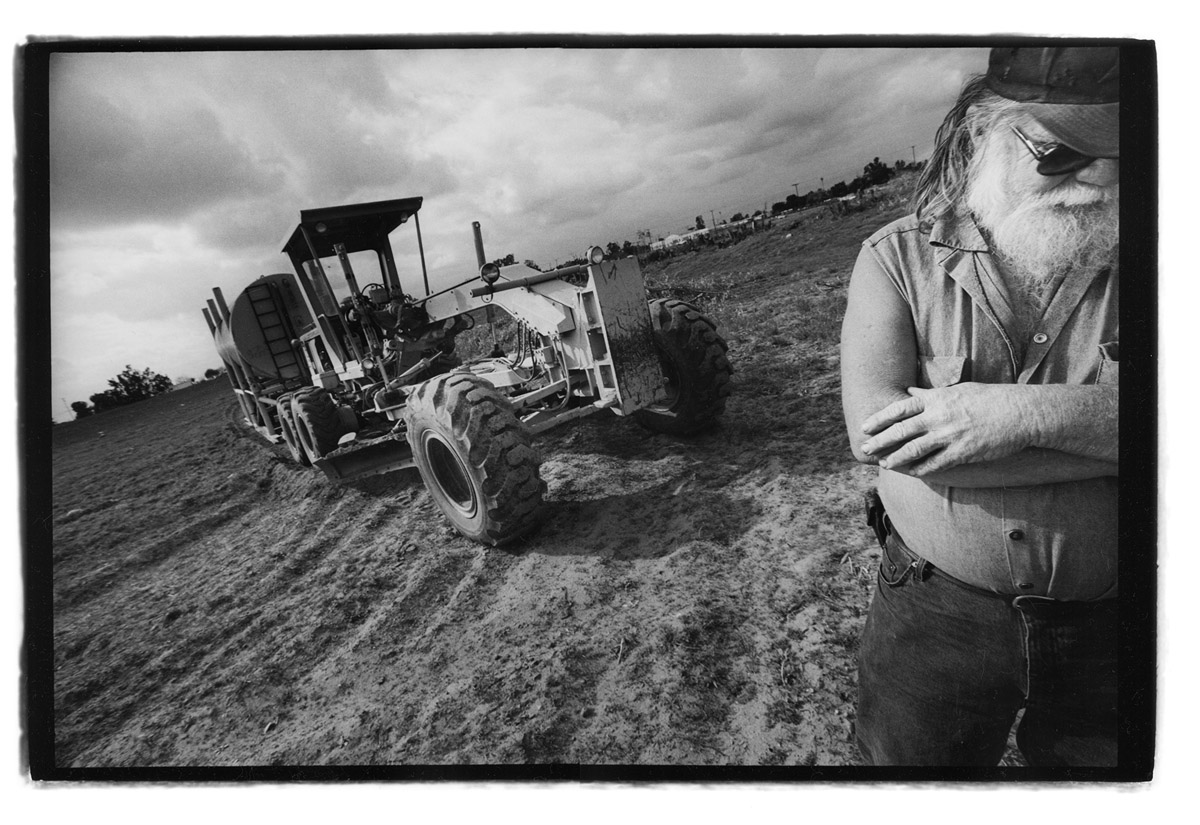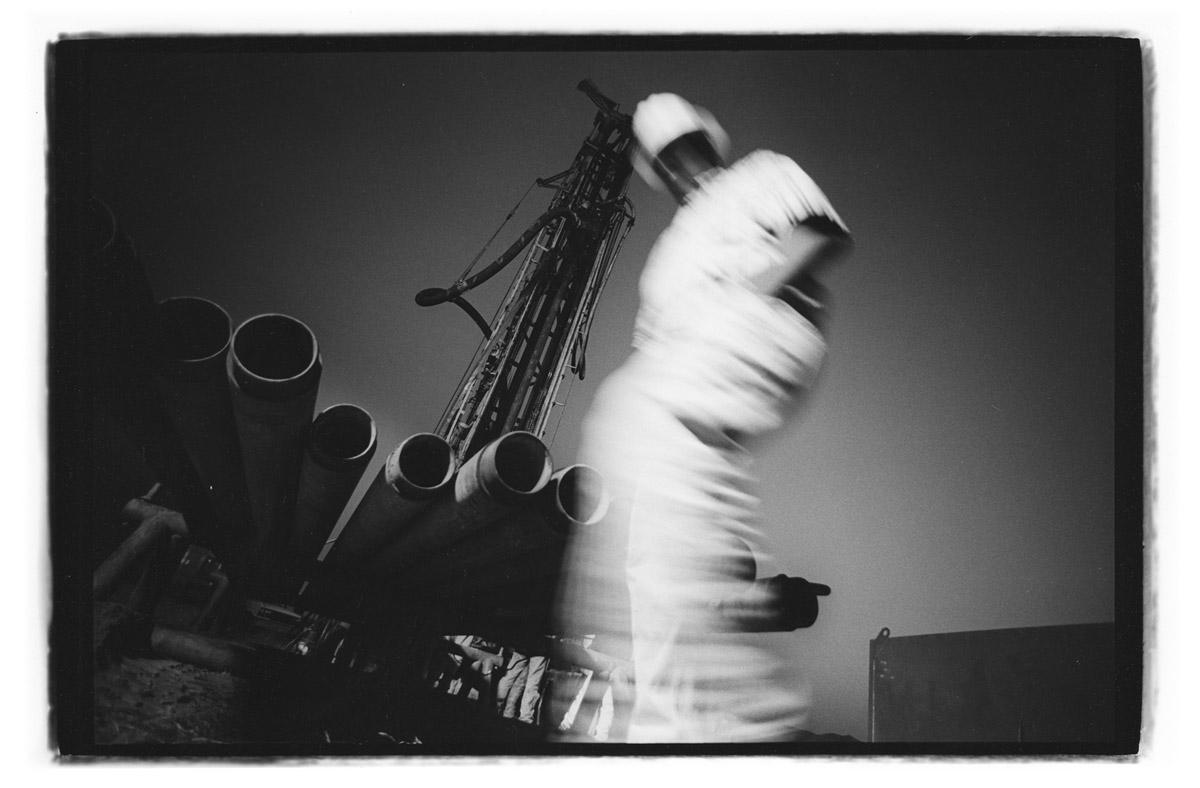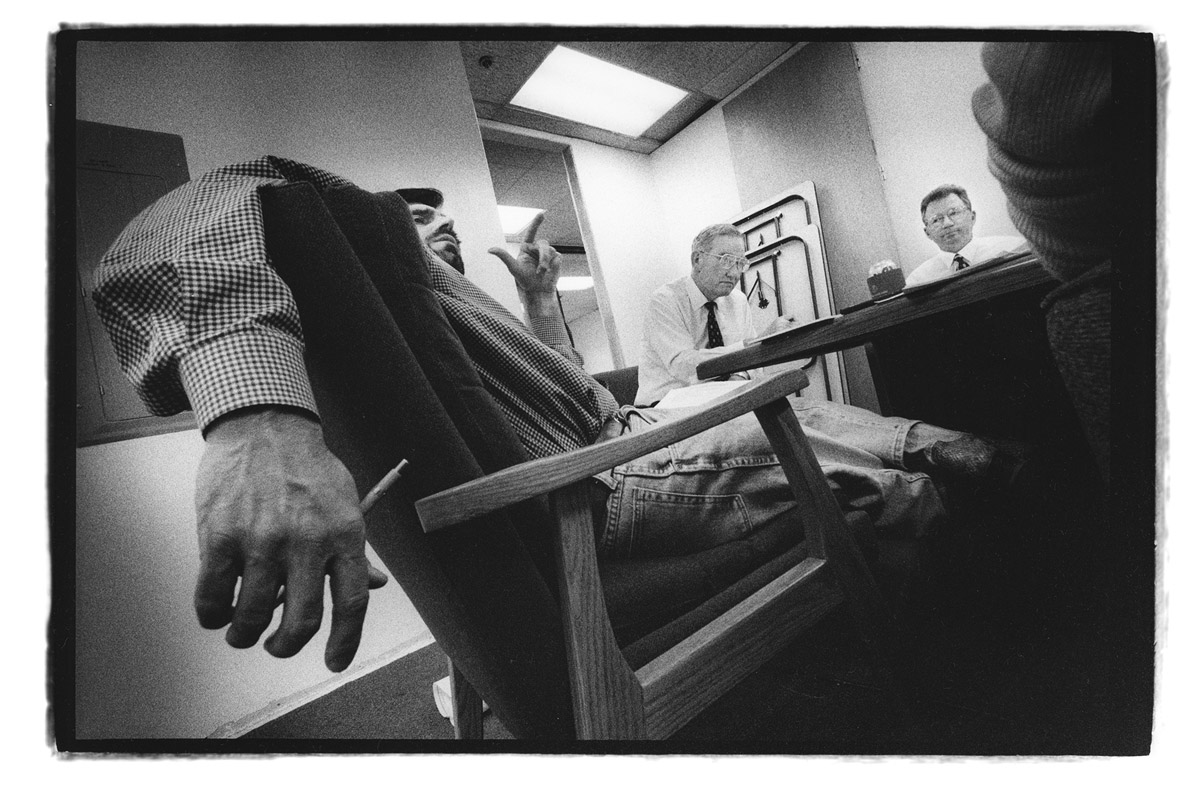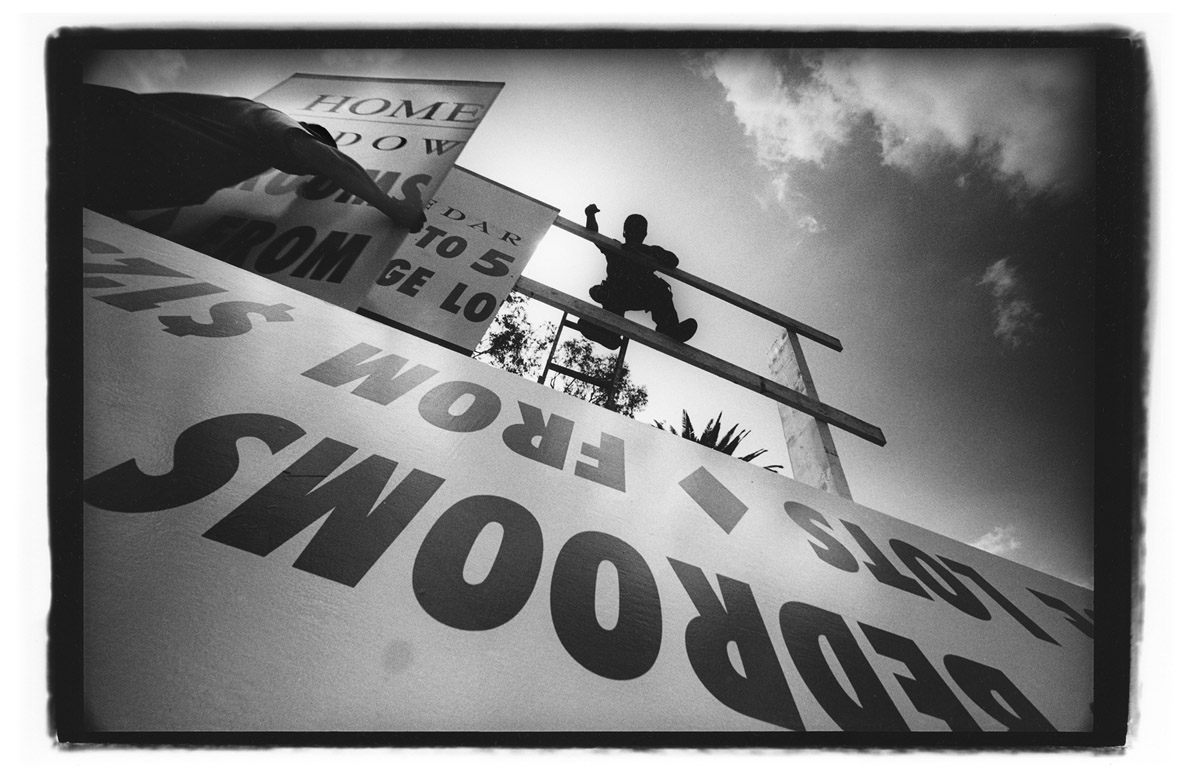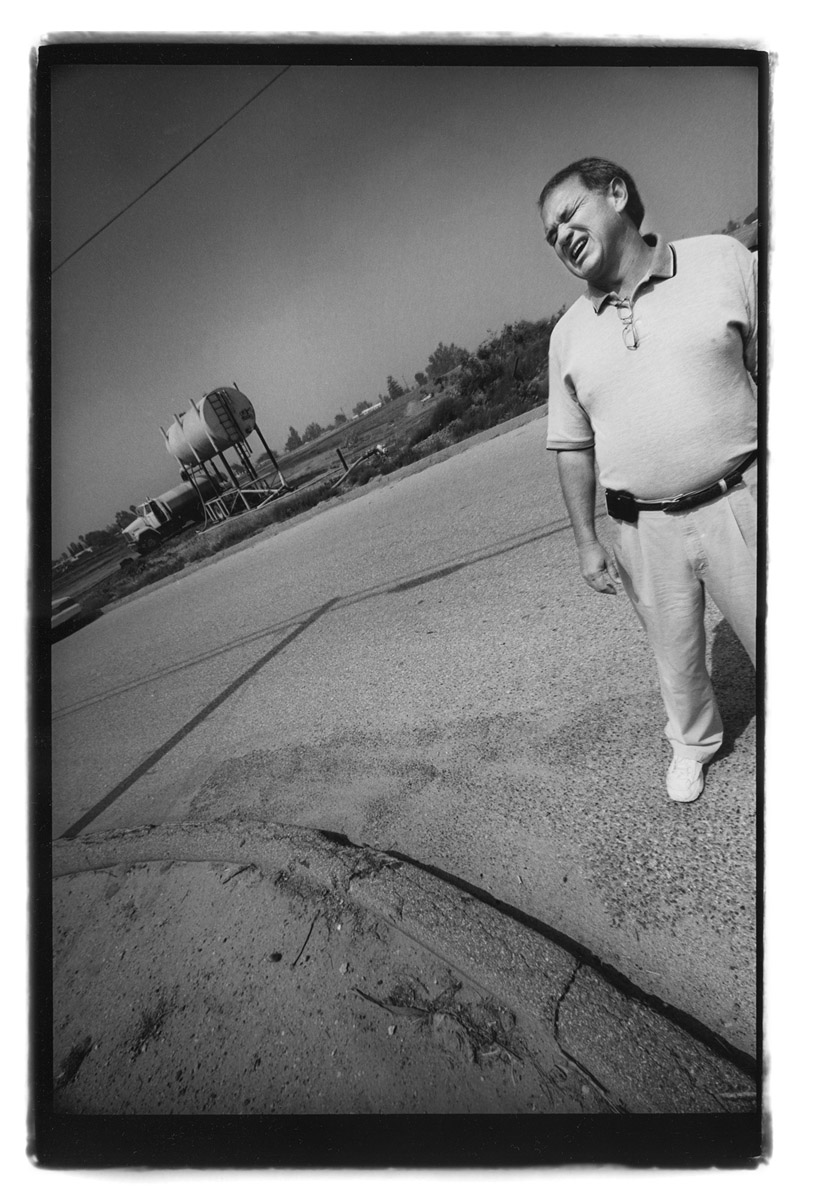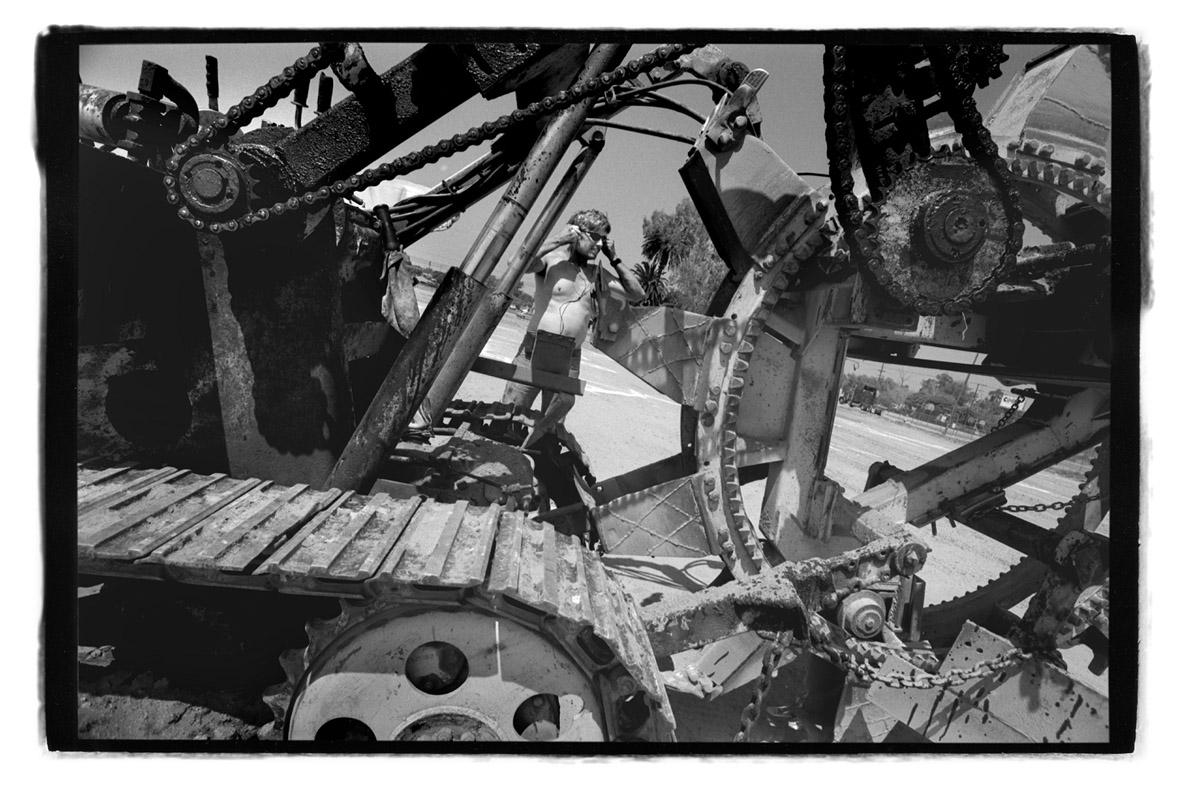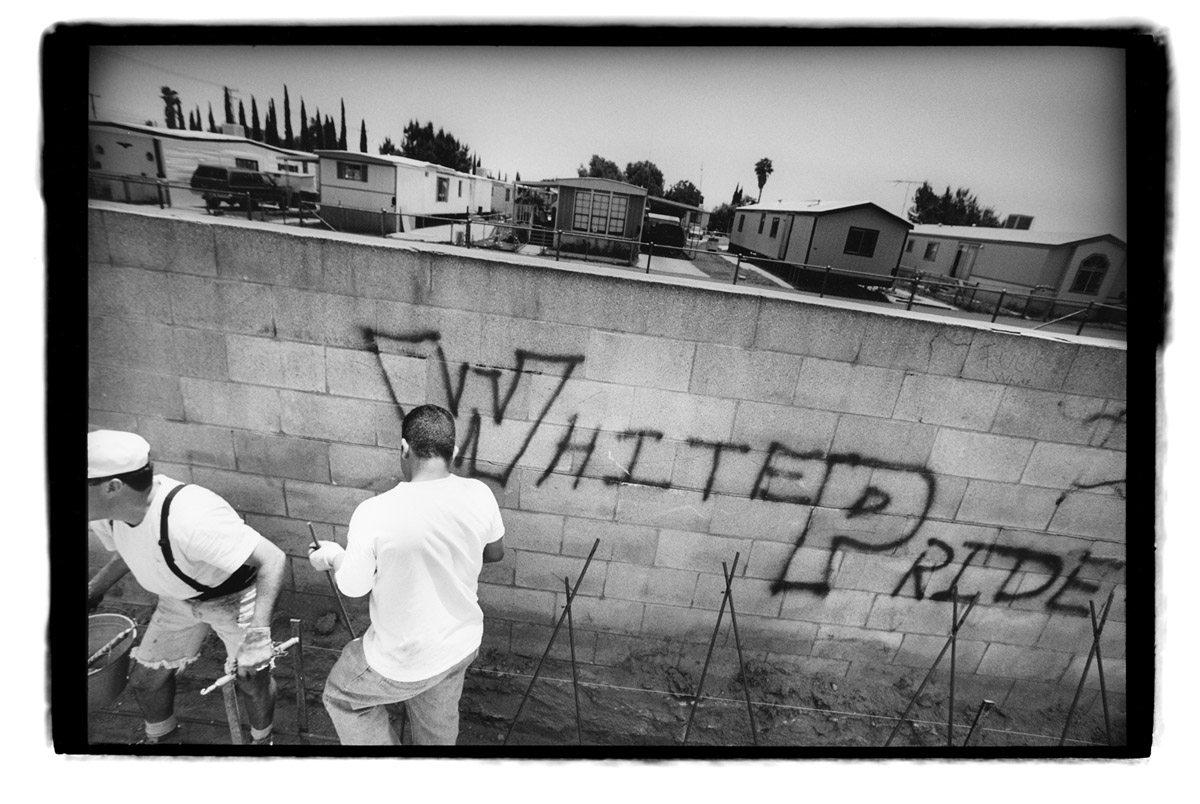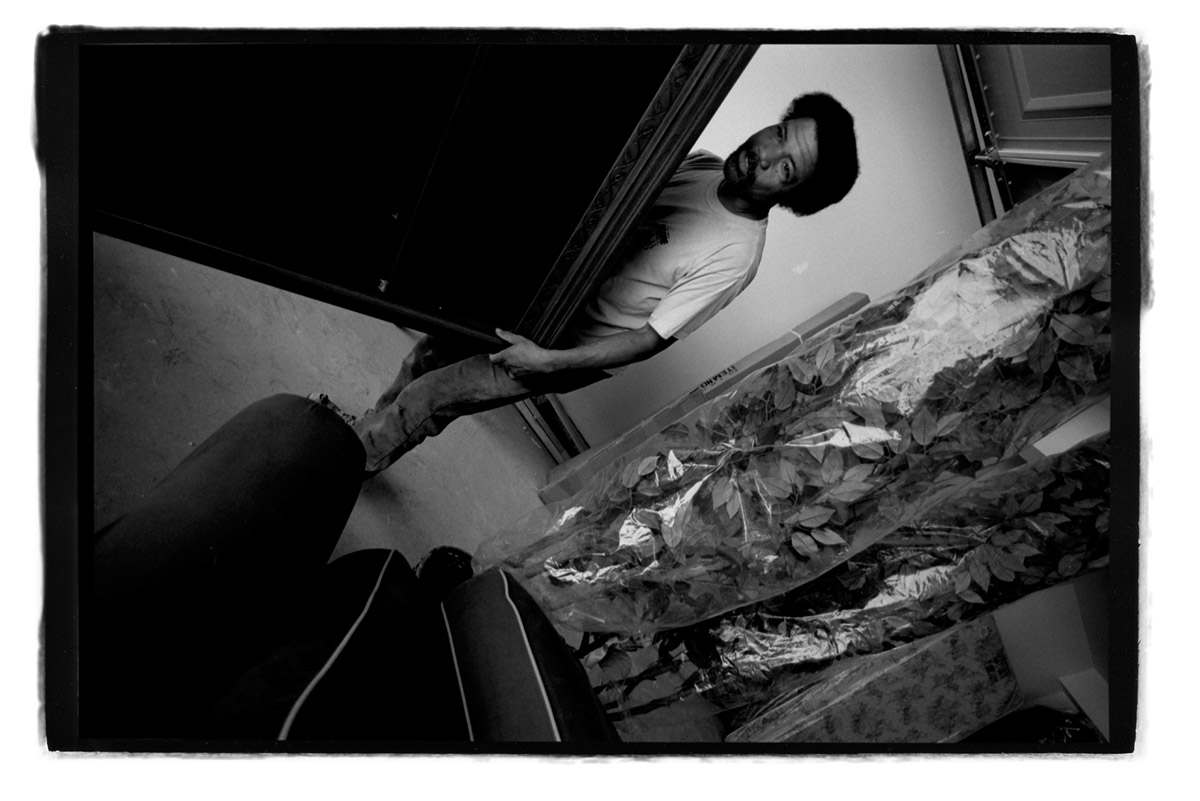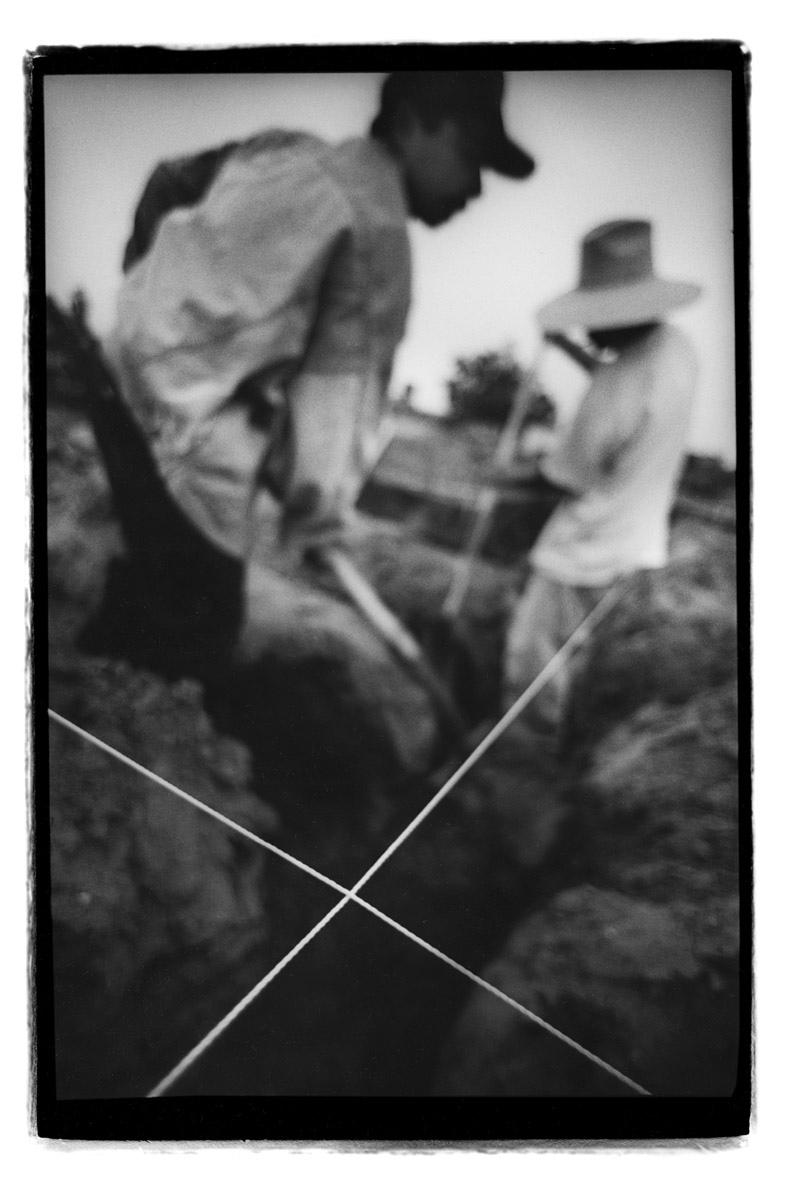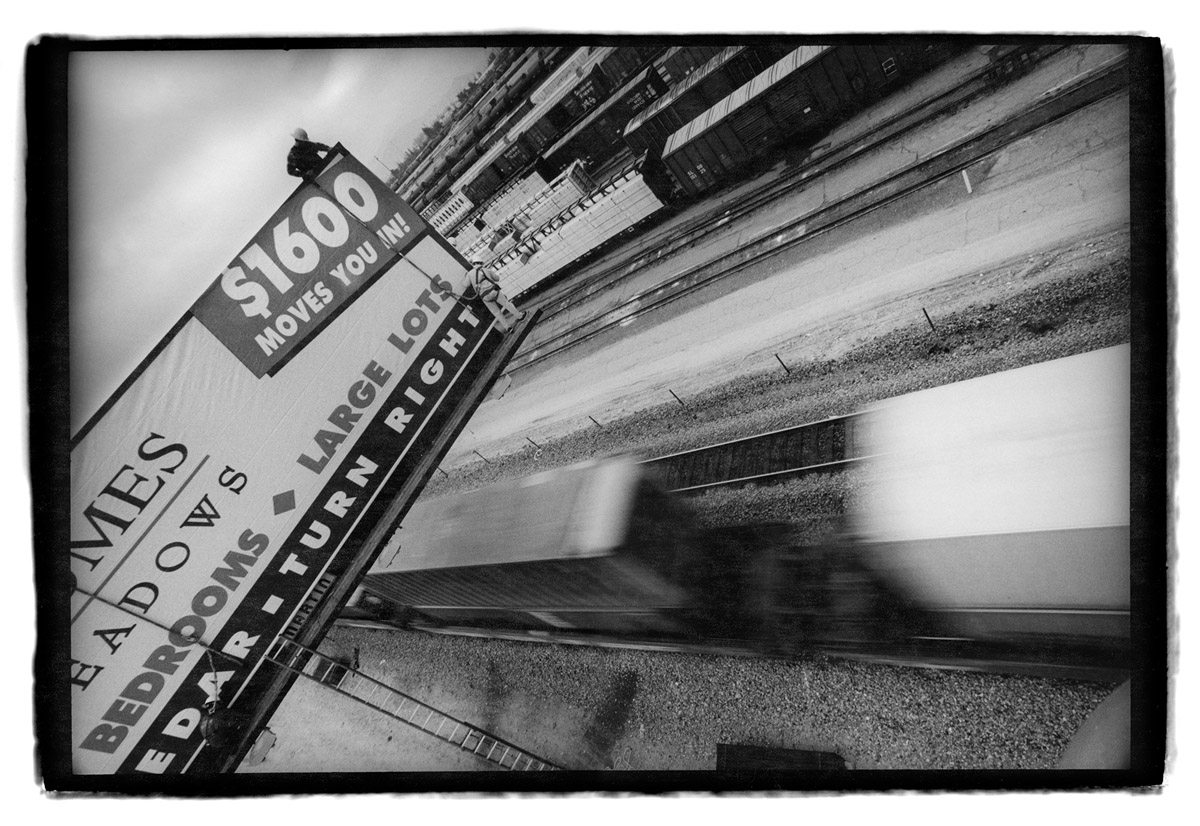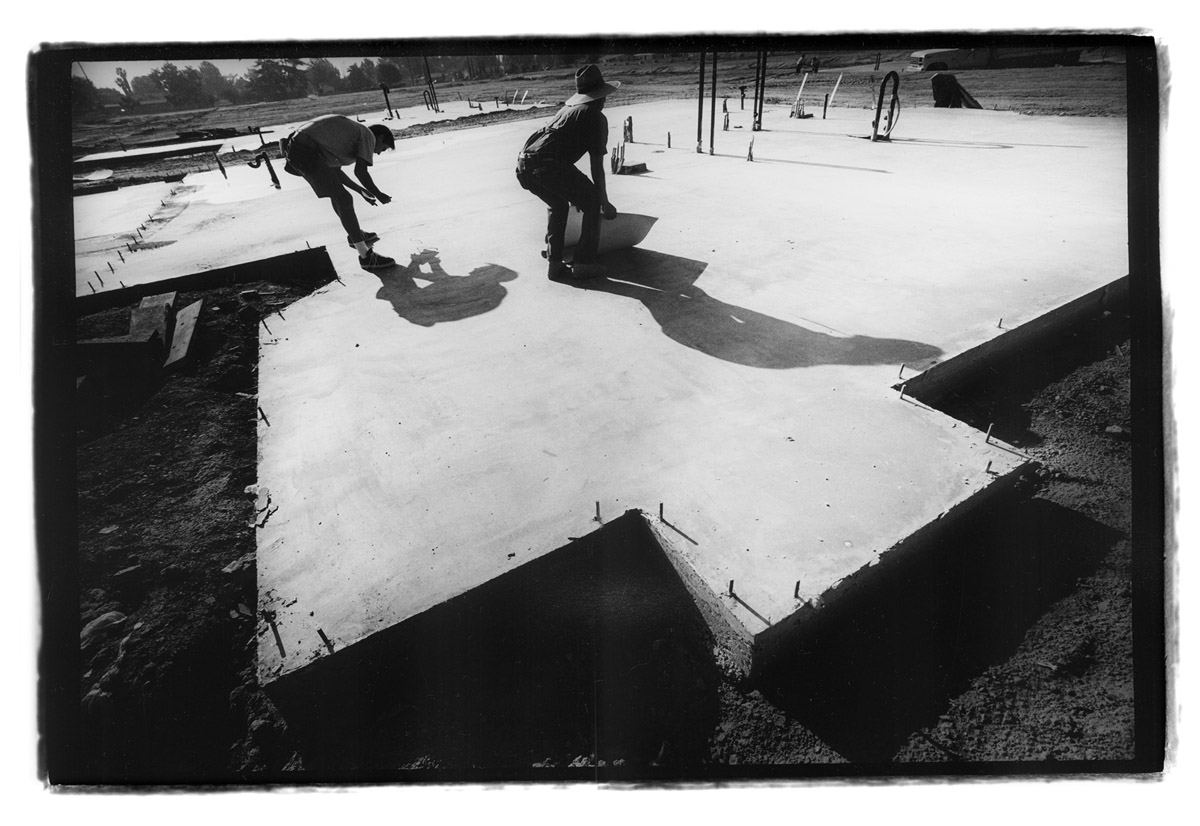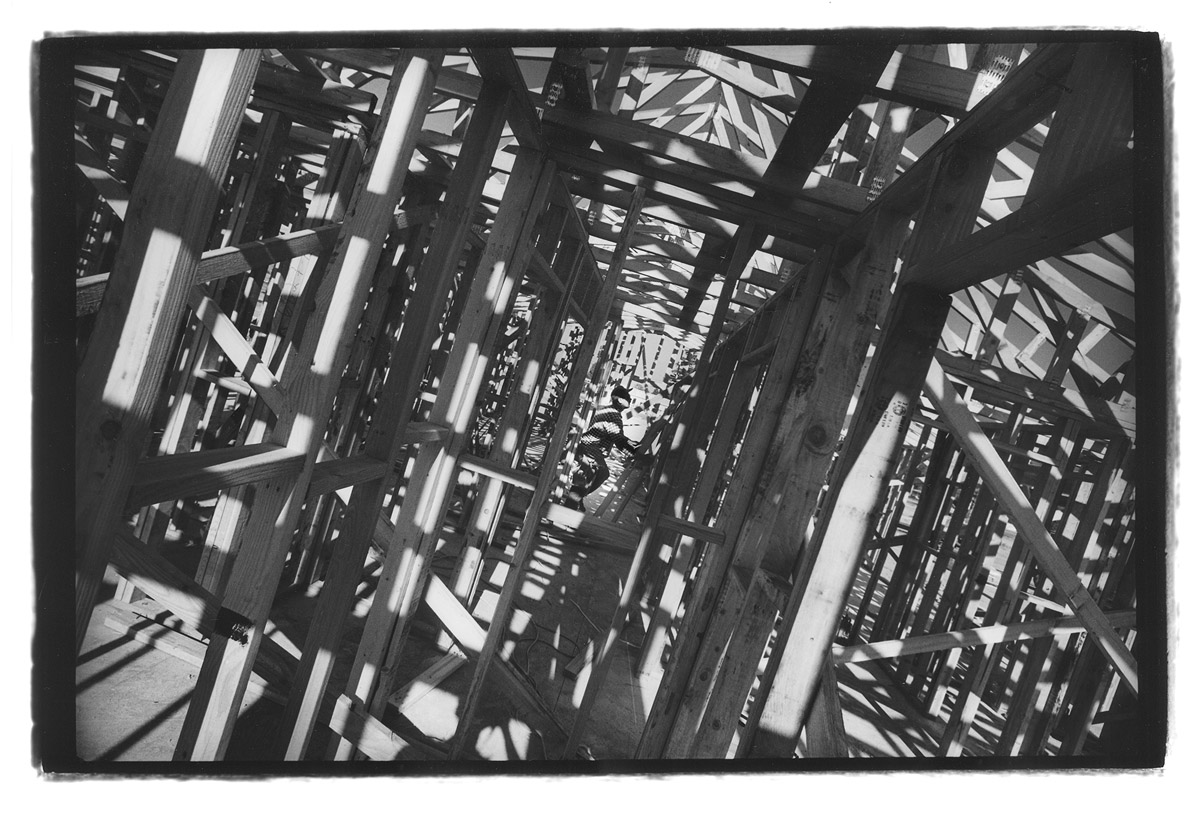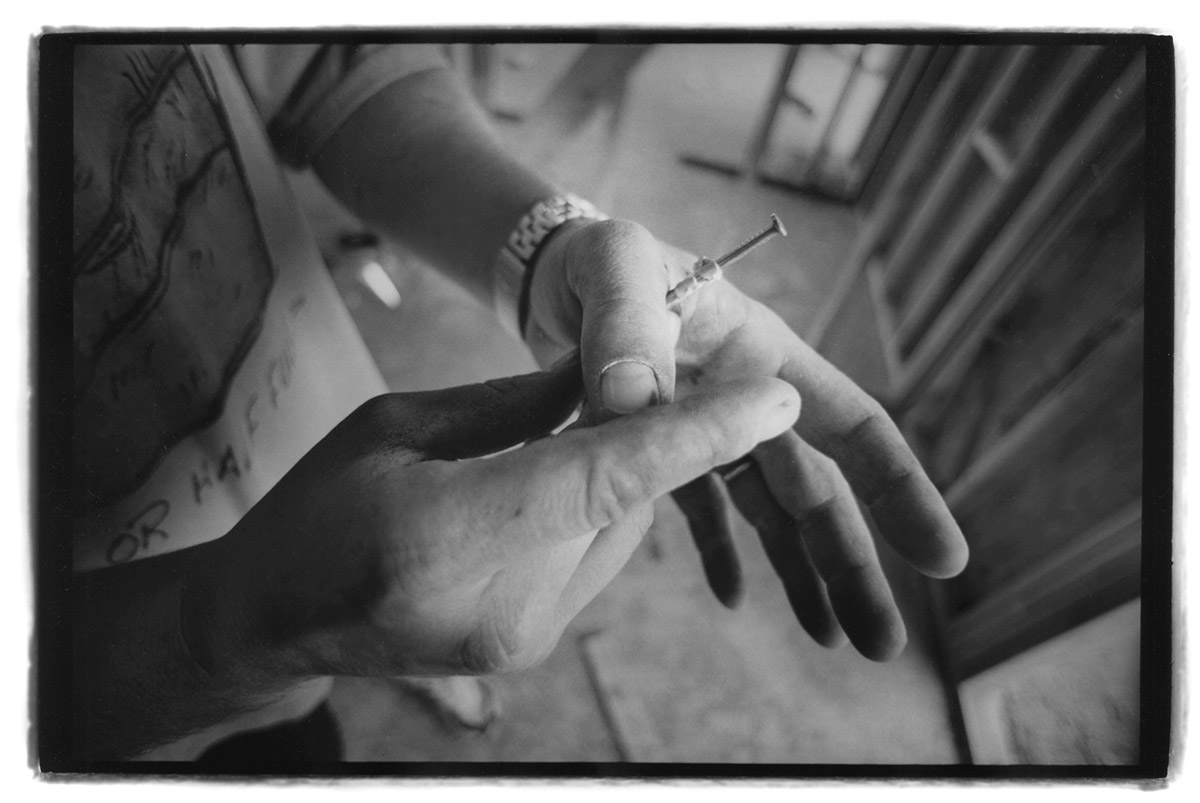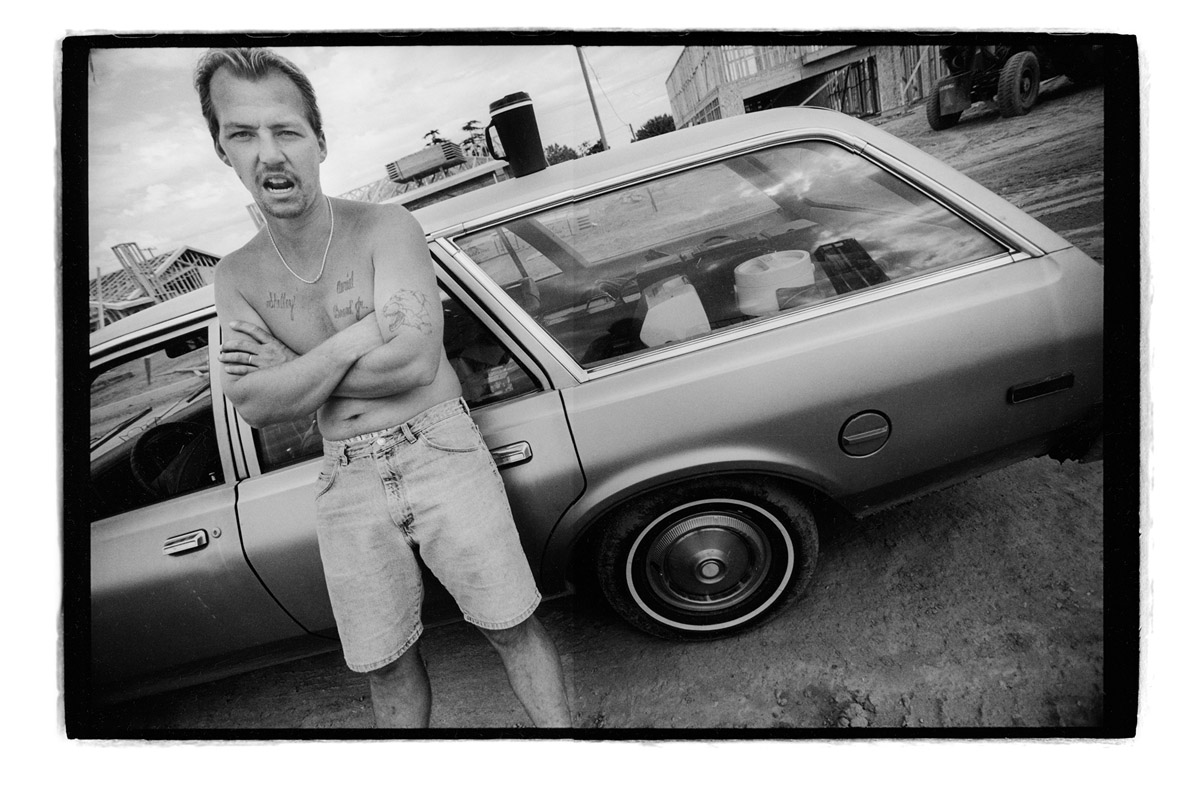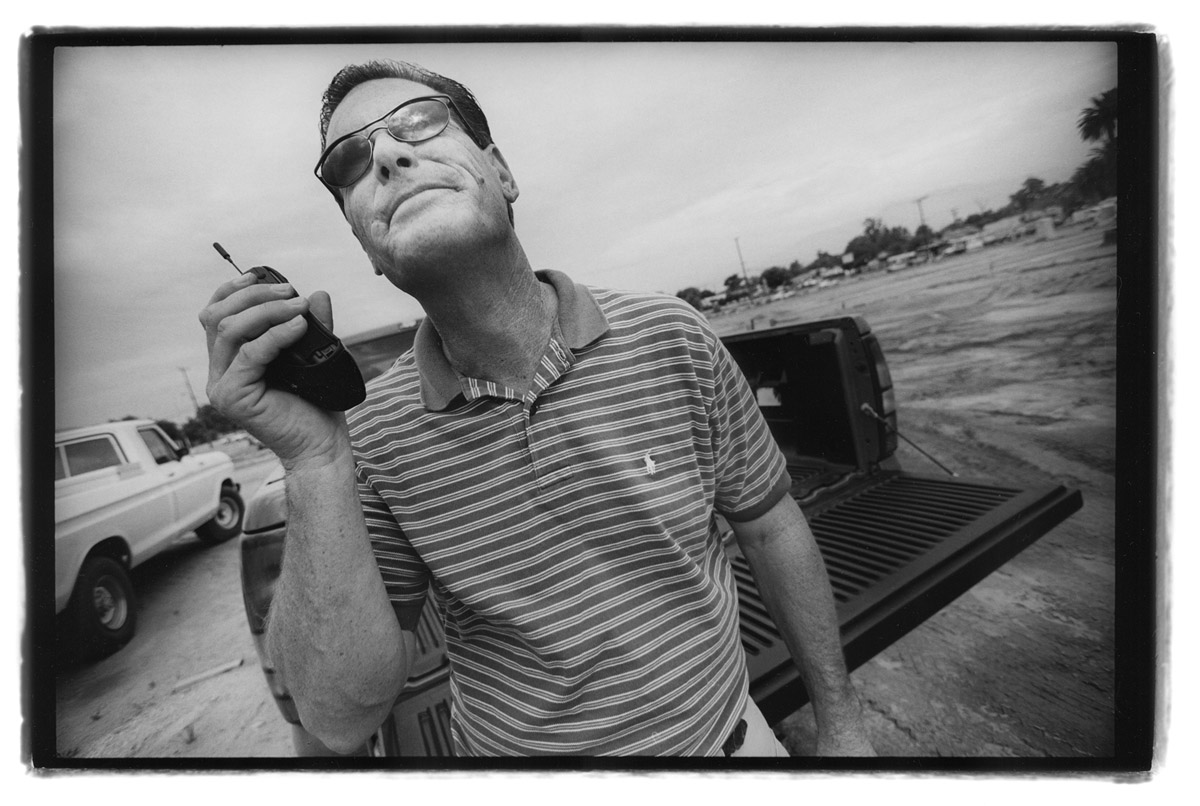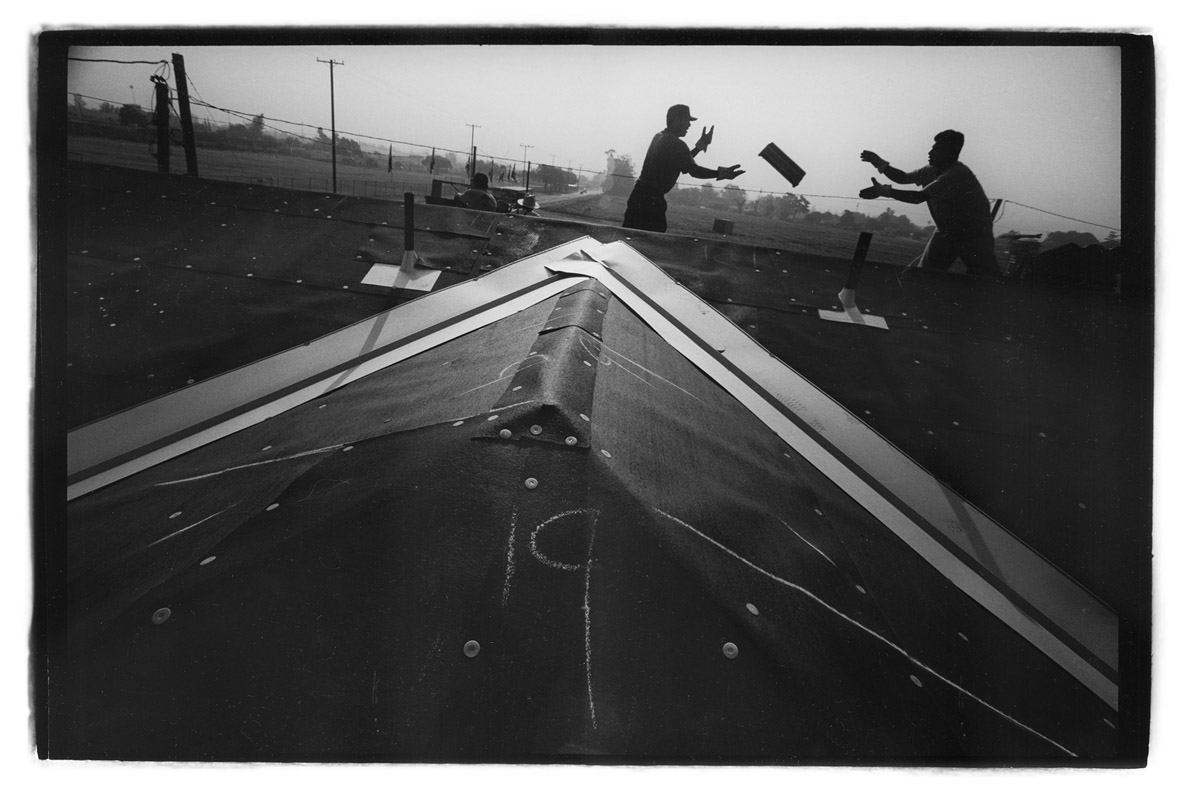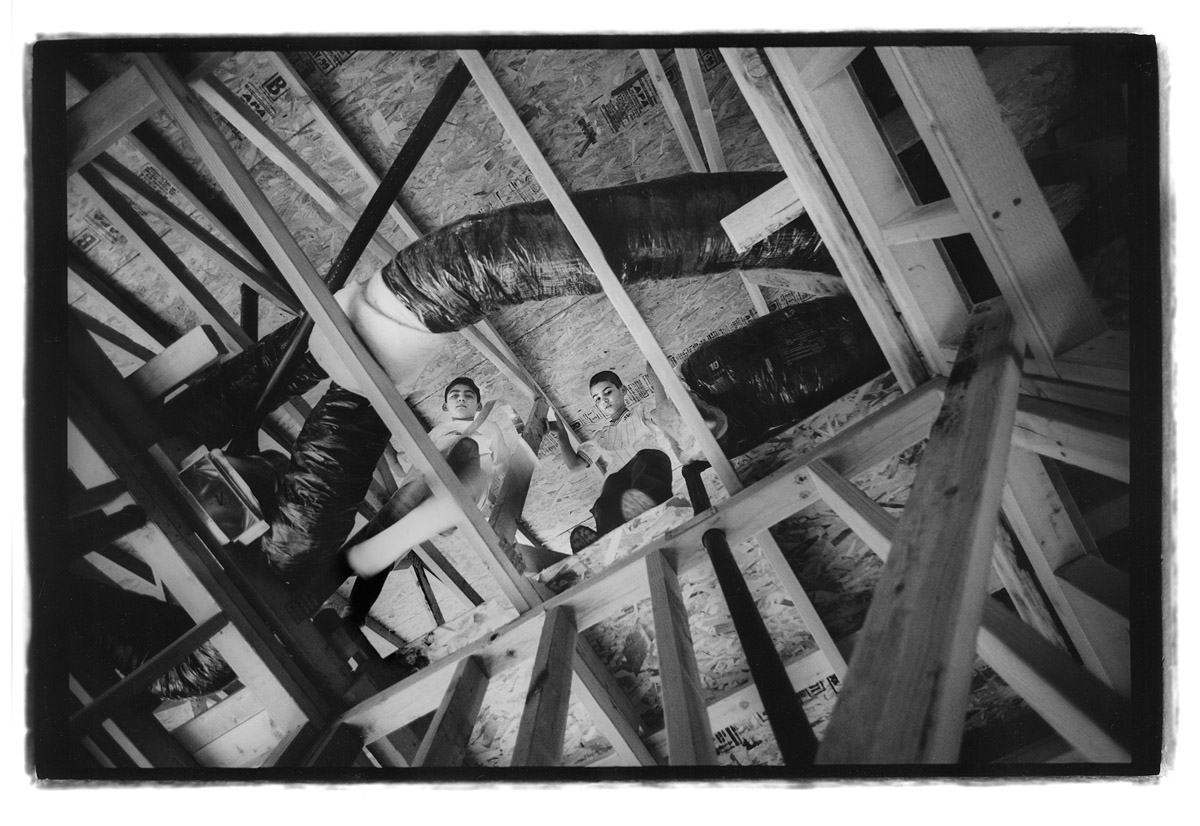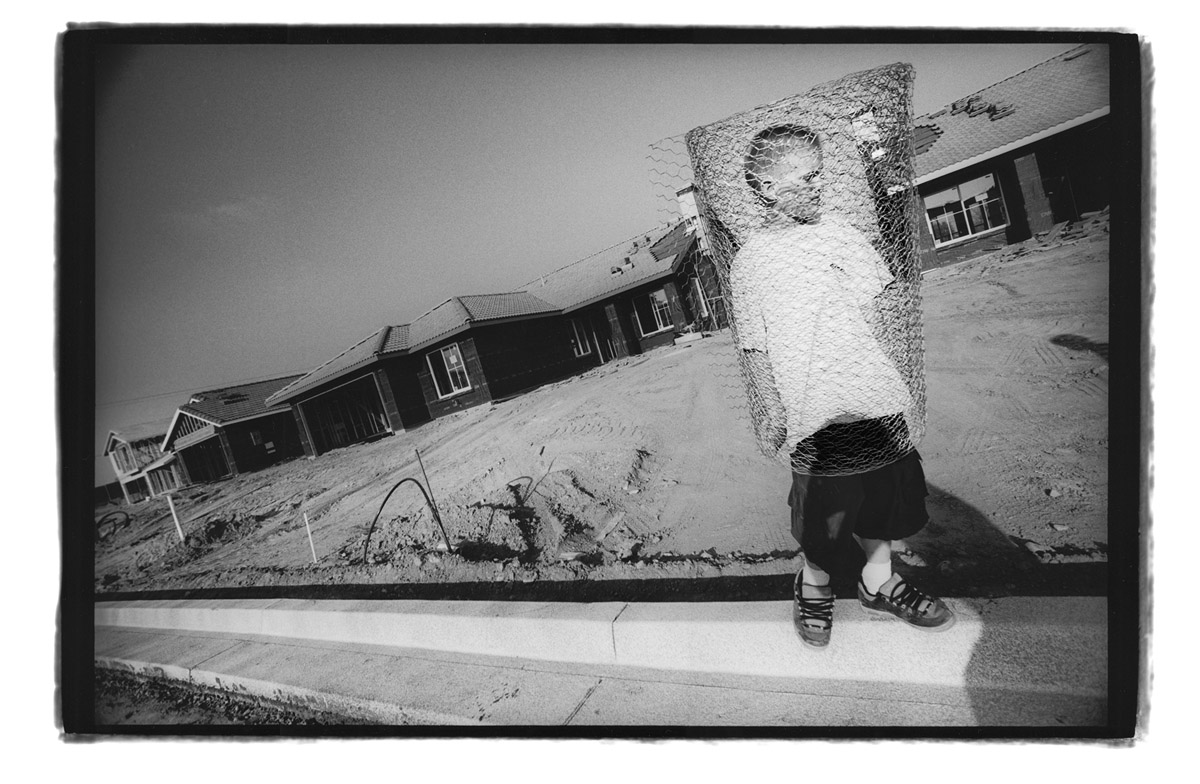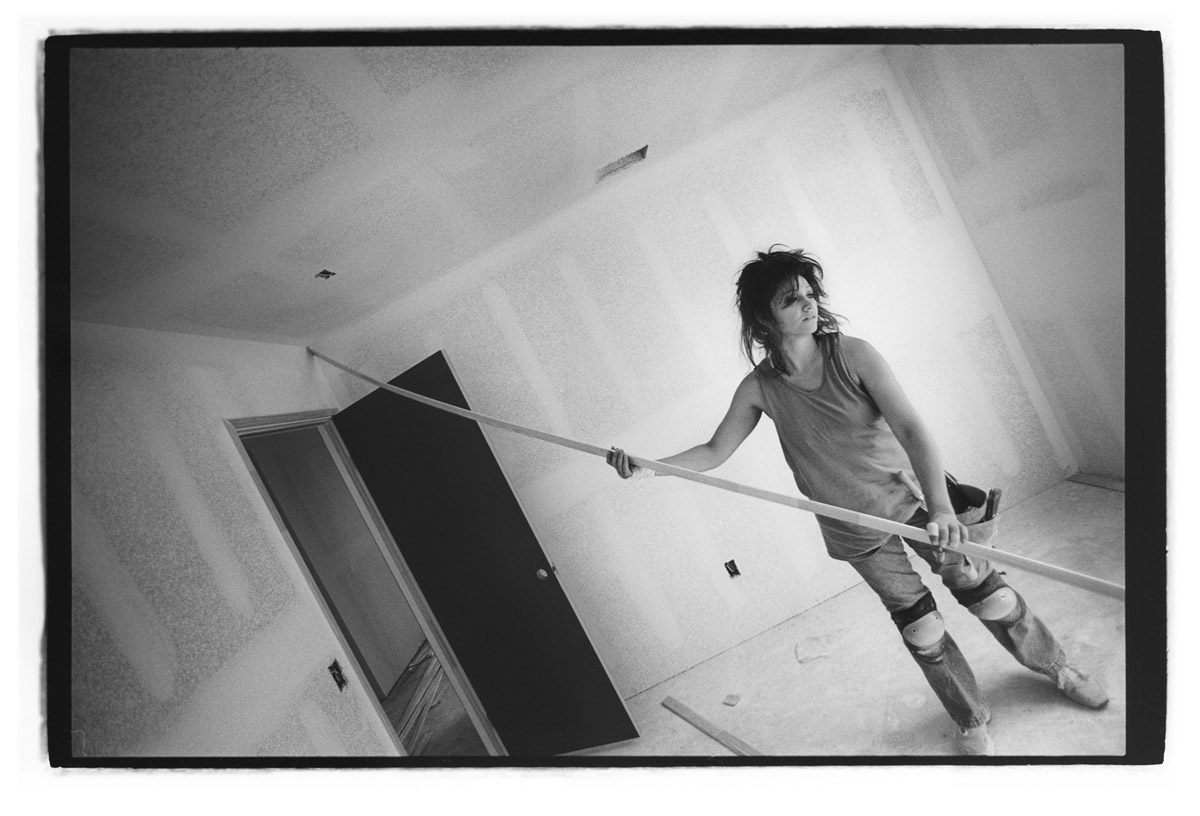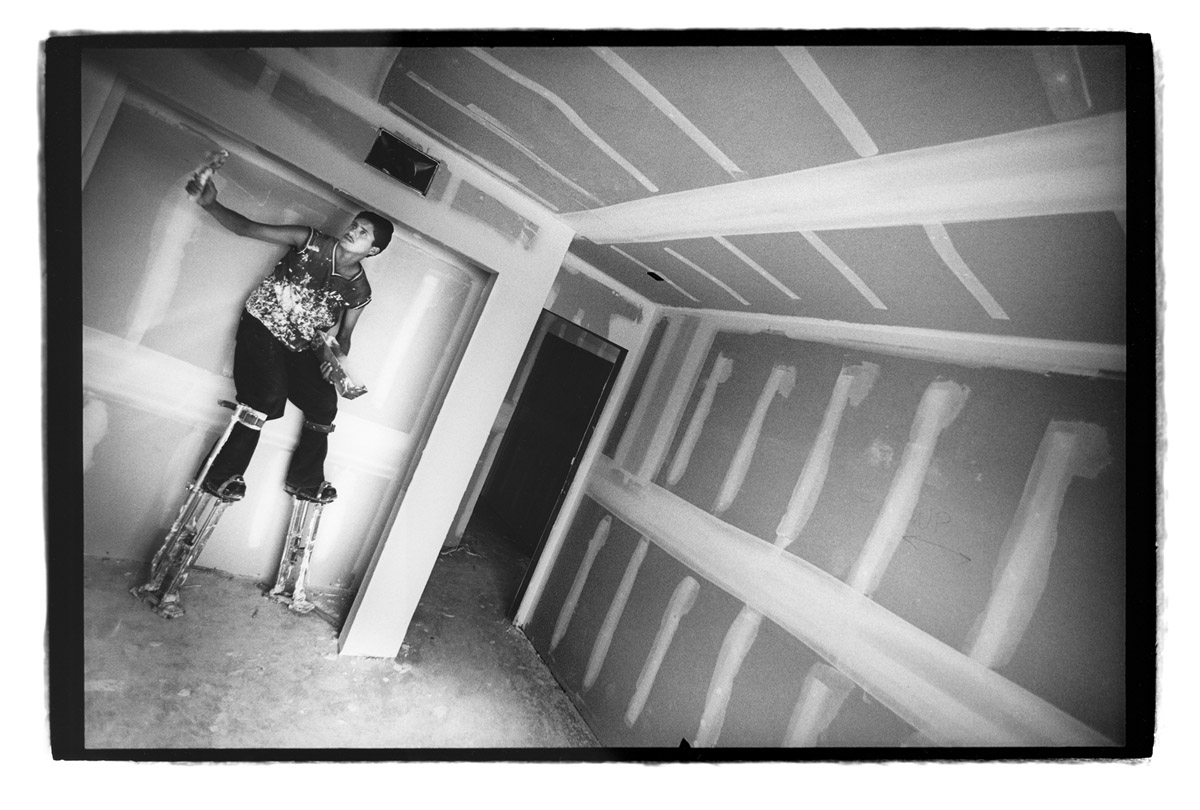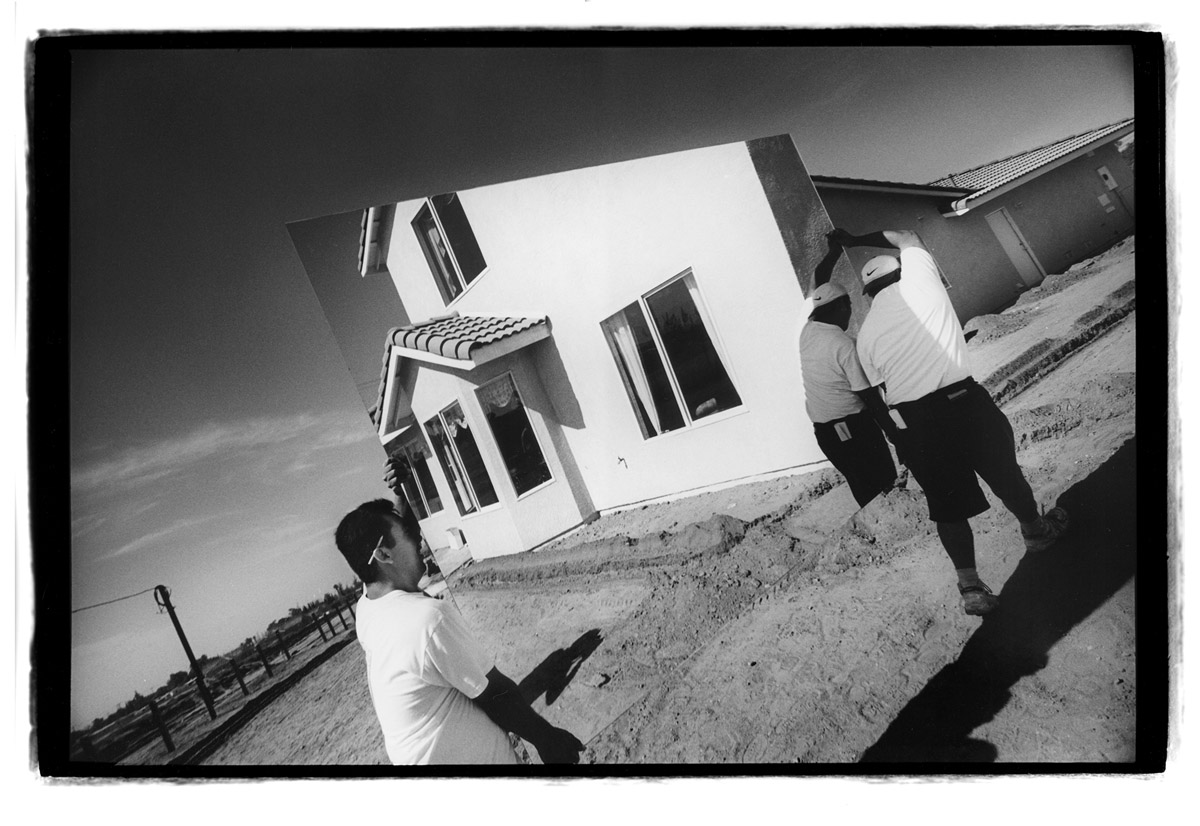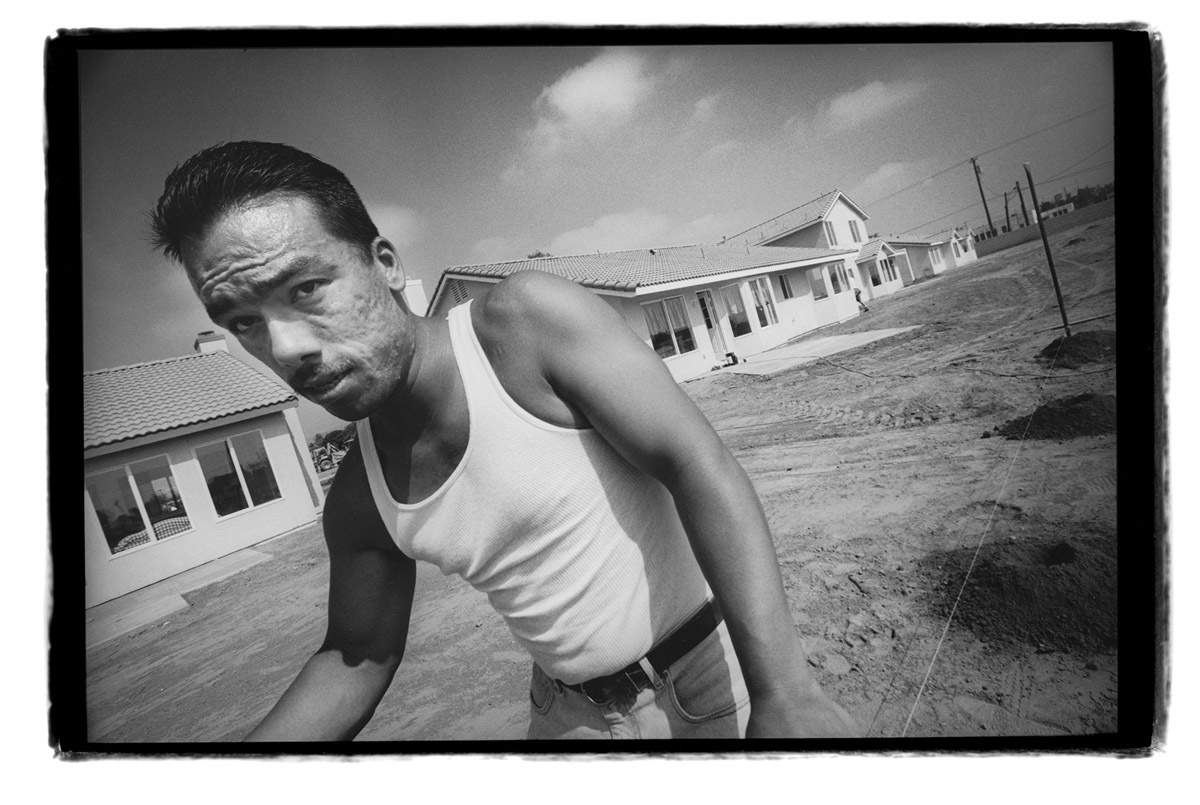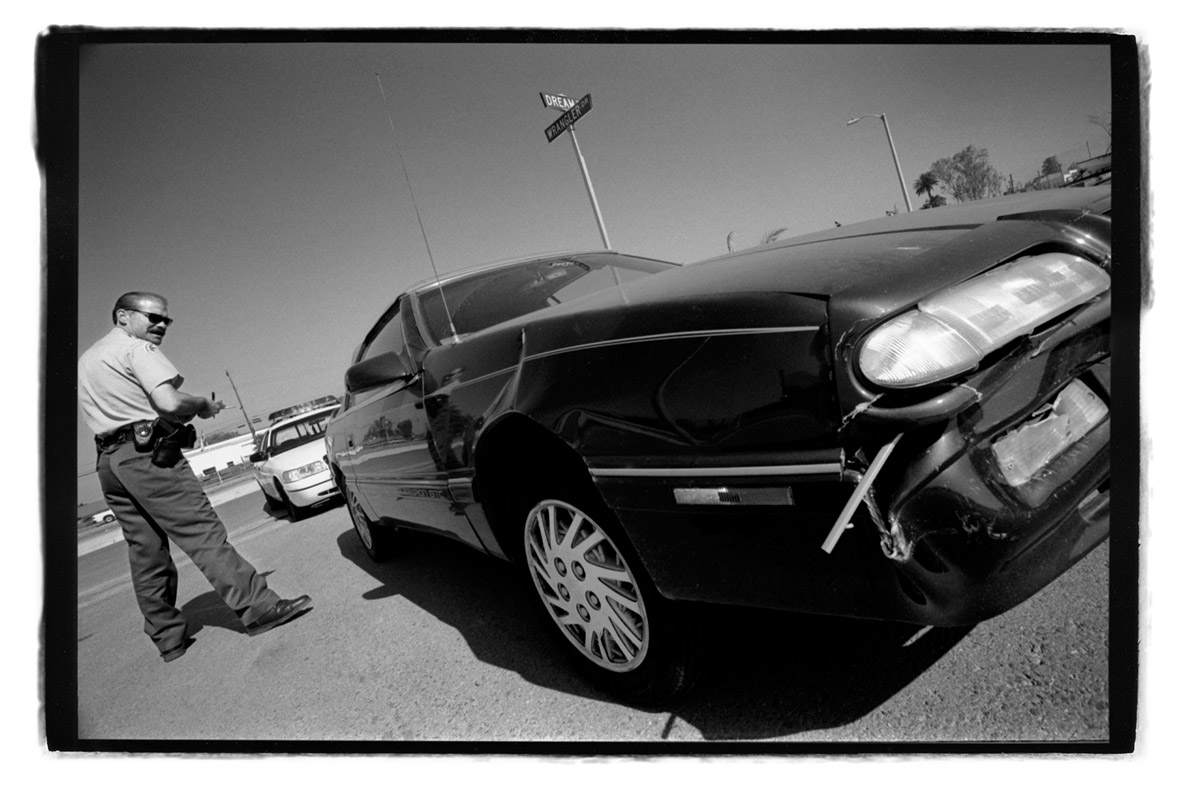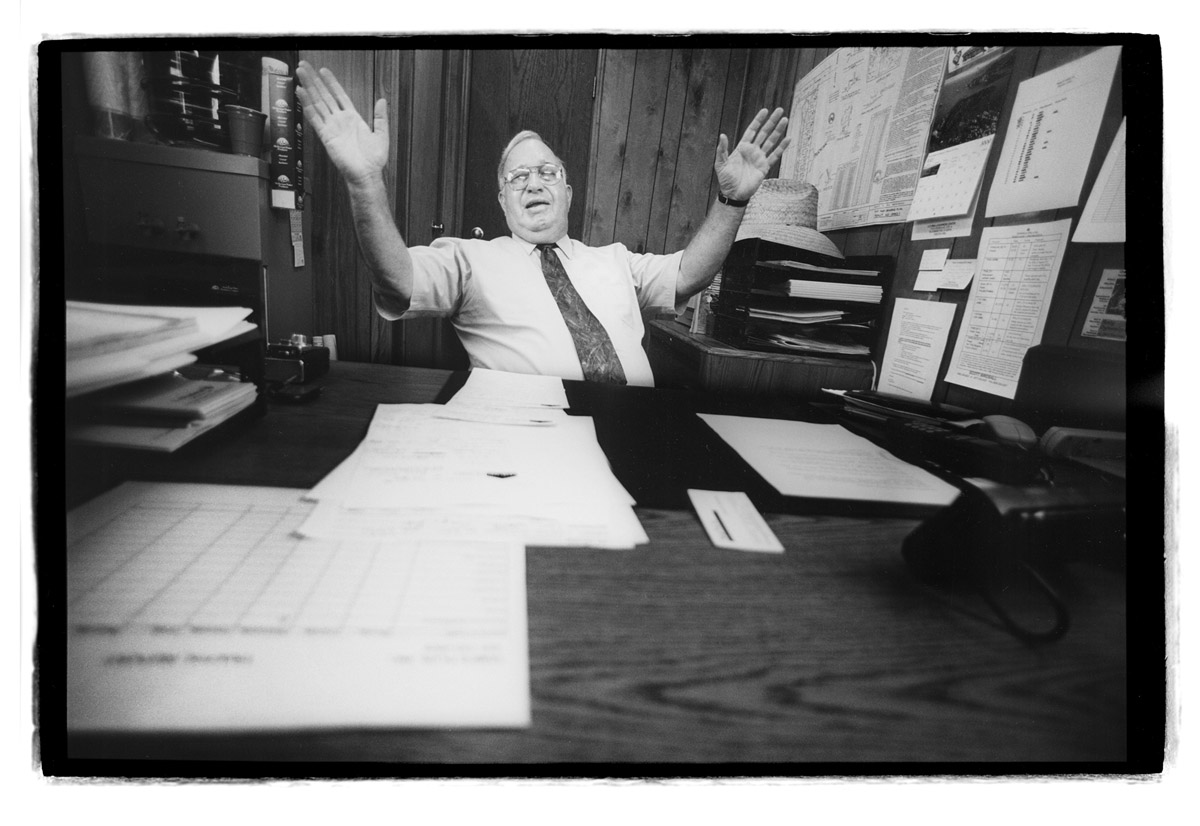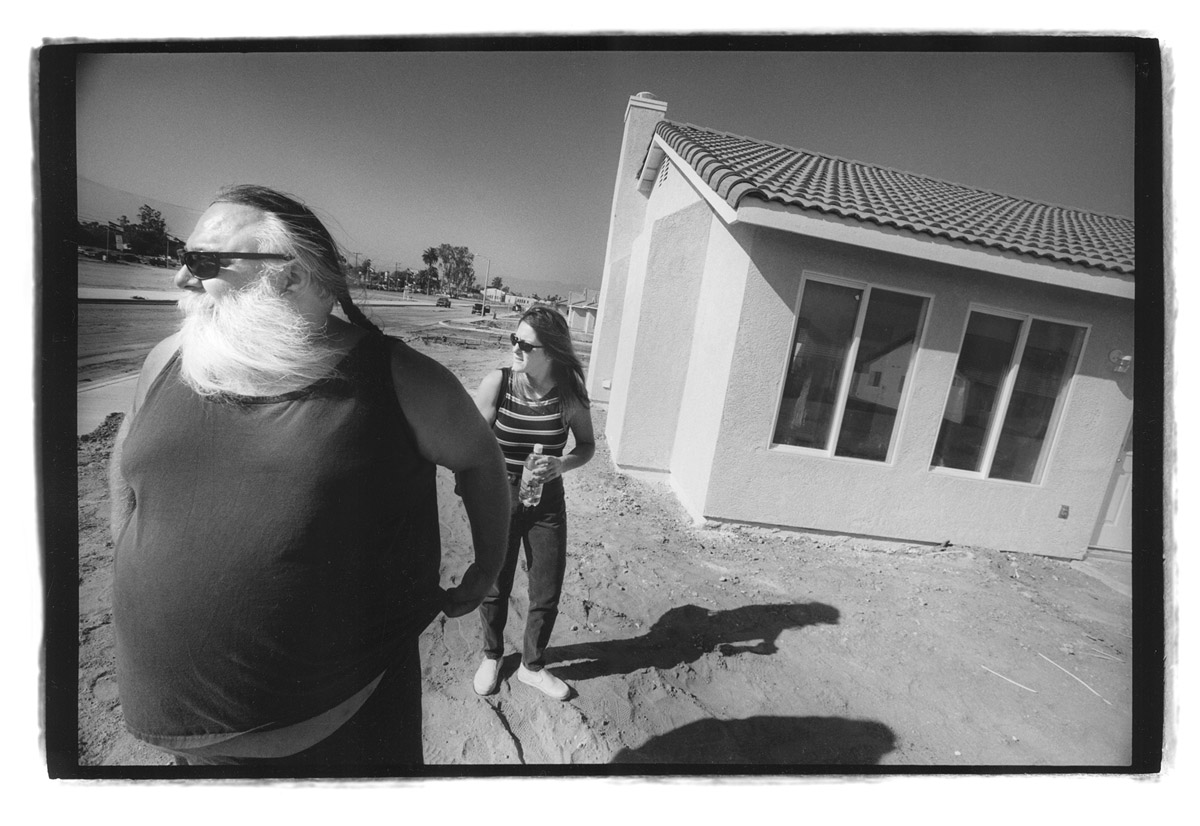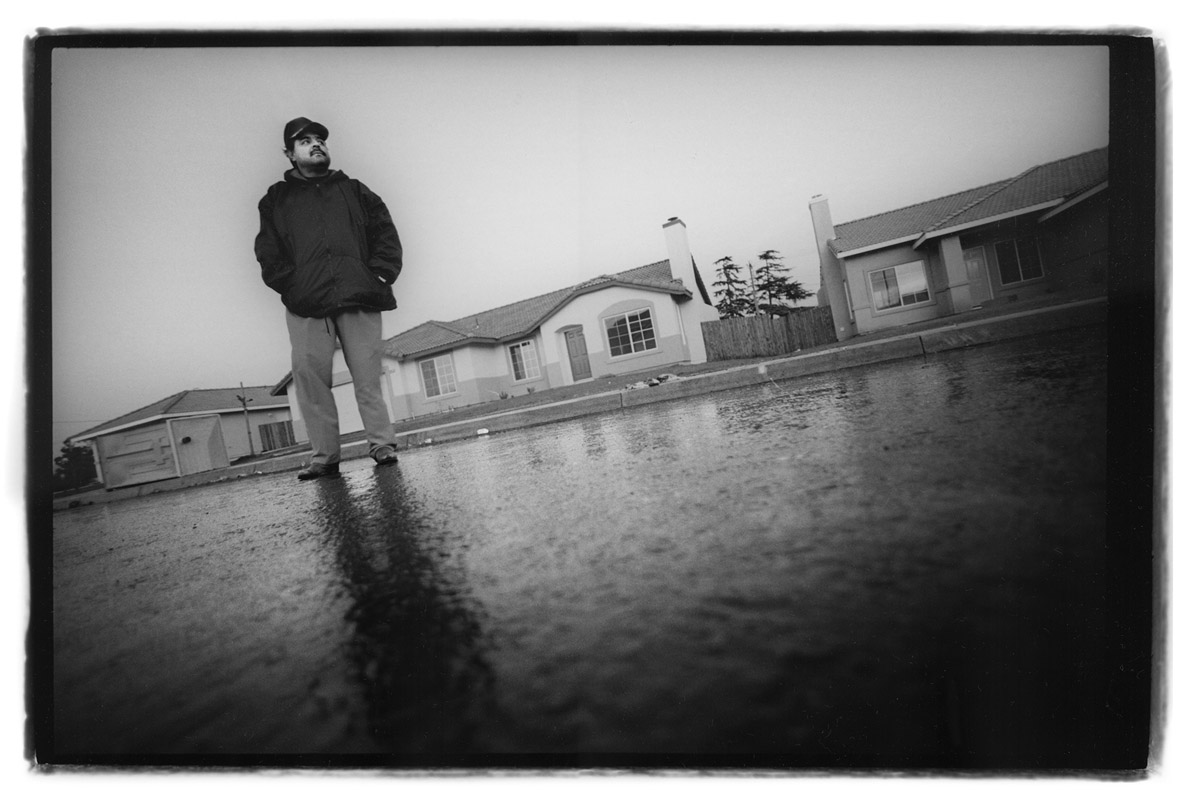Dream Street
Audio
Photo Description
On my first day at Dream Street, I peered at my faxed tract map and walked the stubble-covered field where the street would be. A man in a blood-splattered sweatshirt approached me. Two assailants had beaten Eric to the pavement in a dispute over a bucket of street sales flowers. When he was down, Eric said, they had taken a sharp stick and deliberately put out his right eye. The attack had occurred six days previous and Eric said he was self-medicating with vicodan and vodka. He lurched and sat down amid the straggling weeds. He lifted the bandage to show me how the doctors had sewed his eye shut forever. The stitches looked like black spider legs.
I told Eric that the forty-acre strawberry field was soon to be transformed into 134 houses, that there would be a street directly where we were sitting, and that I had named it Dream Street. A cloud shaped like an eye floated in the eastern sky. I told Eric this was my first visit to the site.
Eric looked out across the forty empty acres with his single eye: "This will look good, look nice, when they—I can see it. I can visualize it."
"A lot of our projects are designed and built for newly arrived immigrants," said Pat Young. Young Homes is a father-and-son operation run by Pat and John Young. "We've always gone in as what we call an infill builder," said John. "We'll find a piece that's kind of been picked over—five acres, ten acres, fifteen acres that nobody's built on, kind of just sat there for a long time, and we'll entice the sellers to sell. . . . So we're amongst older houses."
The first time I visited Young Homes' offices, they showed me around like a trophy—"This is the guy who named Dream Street." Pat and John loved the name because it fit their target market so perfectly-foreign—born, first-time homebuyers.
John told me Young Homes had built 980 homes over ten years. At 134 homes, Dream Street was double the size of their largest previous project. Pat and John were very nervous about it.
Pat: "Every project is that way for us, because we're not large. We're a well-financed small company, but every one of these projects could hurt us if they don't go well. So, we have to make sure they all go well."
The Youngs slid sideways into the house building business. Pat Young was selling real estate when the Reagan recession of the early 1980s savaged southern California. "A lot of builders had trouble and went bankrupt," said Pat. "There were a lot of houses out there half-finished and we ran across one." Pat's idea was to hire a superintendent he knew in Venice to finish the house. As it happens, the half-built house was just down the road from Dream Street. Pat: "We did hire him. And he did finish it. And we put it up for sale and sold it immediately and made $15,000 on it. . . . So there was a lot, or two lots right across the street from this. And so we bought those two lots and then built those two houses out of our pocket and again made fifteen-twenty thousand dollars apiece. It was unbelievable-a lot more money than you make in the real estate business.
The Youngs escalated from there. Three houses just down the street, six more near the cemetery, nine over in Pomona. "I considered myself in the real estate business and we were doing this part-time. But that's exactly how it happened. That's how Young Homes came to be."
Joe has lived in a house across from the Dream Street tract since 1958. The field had been farmed for the entire four decades—strawberries, sweet corn, cauliflower, cantelopes, melons. The farmers sold the produce at a classic California fruit stand under the eucalyptus trees at the busy northwest corner of the property. In the spring every year families came from miles around to pick their own strawberries by the basket. "Eat two, put one in the basket. Eat three, put one in the basket." Joe smiled.
Joe had run up to the corner store that morning. When he returned, the Caterpillar 140G scraper had been dropped off right in front of his house. He'd heard they were planning to build 137 houses, but that construction might be delayed for years because of trouble with a federally listed endangered species—the Dehli Sands Flower-Loving Fly. Joe was wrong on both counts. One hundred and thirty-four homes were already approved and construction was starting immediately. Mitigation money had solved the Flower-Loving Fly problem. I asked what he thought about tract houses replacing farmland. "I'd prefer not, but it's not my land and you can't tell someone else what to do with their land." Plus, he said, he wasn't really in a position to comment. He confessed that he was utterly implicated in Southern California's growth. Joe had spent 38 years and eight days working for E.L. Yeager, the huge California freeway construction contractor.
This is what lies beneath Dream Street: 670 vertical feet of layered sand, coarse gravels, silts, and clays underlain by granite bedrock. Beginning at 220 feet there is groundwater which is so polluted as to be undrinkable. The water is permeated with dibromochloropropane, a chemical which is injected into the root zone of citrus trees to kill nematodes and which causes brain alteration and learning disabilities in humans. I have this information because the local water district began a set of water quality test wells just before the Dream Street grading began. Six wells ring Dream Street. The second one is directly across the Cedar Avenue and the project geologist, Russ Kyle, told me what they found.
Reggie handles land acquisition and permitting for Young Homes. He favors blue jeans and cowboy boots even in big meetings. "A friend of mine who does the same thing—and he's pretty good, too—characterized it—Let's see, what did he say? You've got to be part banker and businessman, part riverboat gambler, part engineer, and part snake oil salesman."
Young Homes had eyed Dream Street's forty acres for ten years, but the project had the scent of trouble. The central challenge was the low-density zoning—two-and-a-half acres per residence. That and the lack of sewer service. Reggie starting wheeling and dealing. To solve the sewer problem, Reggie first looked at septic tanks. But septic fields shed nitrates into the groundwater and you've got to get clearance from a very tough water control board. So Reggie proposed running a new sewer line to an offsite existing main. He then offered to dedicate a chunk of land for public use in trade for much denser zoning across the balance of the site. The Board of Supervisors signed off on the deal.
The construction at Dream Street didn't start with houses, but with marketing. A three-man crew from Hoke Outdoor Advertising in Orange County arrived to put up a large sign. The crew drilled their postholes on the northwest corner where the fruit stand had been. The field was left fallow when the property was sold for development two years earlier and the fruit stand was torn down and hauled away. The sign guys were happy to be there. "This is close, man. We go to Texas, Arizona, Las Vegas," said George. "Load up the truck and go. Three days, five days, six." In large black vinyl letters, the sign read "Up To Five Bedrooms • Large Lots • From $125,950"
The Young Homes marketing people hung a press release about the tract on the story of my naming the street. They sent out a photographer named Ed to take my picture. Afterward, we stood around and talked photography. Ed had been a high school photo dweeb, but he abandoned it as he climbed the Cask 'n Cleaver chain from busboy to waiter to restaurant manager. Three armed robberies at three different steakhouse stores pushed him back into photography.
Robbery One: A lone gunman held up the restaurant and forced Ed to open the safe at gunpoint. When Ed's second effort to open the safe failed, the gunman cocked the handgun and held it against Ed's skull just behind his right ear. The gunman took $18,000 and locked everybody in the walk-in freezer.
Robbery Two: A pair of masked gunmen burst in on Ed and the floor manager as they were counting the night's receipts. Ed's wrists and ankles were bound so tightly with phone wire and duct tape that he was sure he would lose his hands. He was forced face down on the floor and a shirt was thrown over his head. He heard a gun cock inches from his head. He felt the blast of the gun and a gush of warm blood. At first he thought he was shot, then assumed the floor manager was killed. Neither were injured; the warm blood was spilled coffee.
Robbery Three: A seventeen-year-old burst through the restaurant front doors with a pistol. Ed had visited his psychiatrist that morning to deal with the aftermath of the previous robbery. The gunman swung his pistol wildly. The gun hit an entryway post and gave off a distinct plastic sound. Ed threw the gunman through the double front doors and mashed his face into the concrete wheelchair ramp with such ferocity that the kid required reconstructive surgery. Ed quit the restaurant business and resumed photography.
By the time Al slipped on his walkman and fired up the machine to trench the foundations for the model homes, I was getting curious. I had already spent days at Dream Street and I had yet to run across a genuine Young Homes employee at the site. Plenty had been accomplished, but it was all done by subcontractors. It was beginning to feel like there was an infernal machine that automatically churned out housing tracts. What did it feed on? Who hired the cogs? How did they get paid?
I started with Al. Al has been doing trenching for tract homes since the day in 1977 when he took out a bank loan to buy a used truck and trencher. He isn't paid by the hour and doesn't make a salary. He doesn't bid on the job, make an estimate, or get a lump sum payment. Al is paid by the linear foot—fifty cents per linear foot of finished trench, sixty cents for two story houses. Al has no job security, disability protection, or retirement. There is no overtime, no vacation, no health plan, and no union. He was my first encounter with piecework.
I was there when they poured the first slab for the first model home. Oscar directed the trucks and Juan ran the finishing. Oscar used a system of sharp whistles, yells, and hand gestures to control the concrete trucks. The first driver peered into his sidemounted rearview mirror and tried to decipher Oscar's signals. The system broke down immediately. The truck lurched backward and the steel chute broke two pipes off deep beneath the sloshing concrete. There was a stream of salty Spanish and some English, too. The crew shoveled down to the sand and visqueen and built a small dam to keep concrete from hardening in the damage zone. I got in so close as the pour continued that concrete splattered on my clothes, hair, face. Seven globs coagulated on my yellow Y2 filter.
Later I stood and talked with Juan (wearing his customary big hat). He's worked on the concrete crew for ten years "making the good American money," he says, but he longs to take his wife and two young children back to Mexico. I made Juan a set of 16x20 prints. But when I tried to find Juan a few months later to give him the photos, Oscar told me he had given up his rental house and moved back to his hometown in Oaxaca.
Jesus and Jesus walled out Dream Street's neighbors. The 219-space Cedar Village Mobile Home Park shoves a quarter-mile of double-wides against the tract. Young Homes thought the visible underbelly would scare off home buyers. So they hired Jesus and Jesus to build a concrete block wall along the boundary. Then they topped the wall with a six-foot wood fence.
One Jesus [with the white cap] speaks only Spanish. He goes by the name Chuy, a Spanish diminutive for Jesus. The other Jesus goes by the Americanized name Jesse. English-only speakers like Jesse are said to have been "whitewashed." They are called "coconuts"—brown on the outside and white on the inside.
Said a boss: "Immigration has been called on jobs at times. We were in Ontario and immigration was called. Immigration raided the job and took all the Mexicans and took 'em all back to Tijuana. And the next week they were all back again. Basically to them, they got a free ride back to visit to their family. And, you know, vacation—wheeehaa. You know what I'm saying? It really doesn't phase them. They'll really not scared shitless or anything like that.
"They run. They try to get away because it's an inconvenience, because they're going to miss some work. But after they're caught and they're on their way, it's just a free ride to Tijuana, drink some cervesas, visit mom and dad, and be back Monday for work. It's so funny, because it is—not exaggerating—just totally like that. I guess [my company's] thinking is, 'Why not exploit them?' "
Day laborers occupy the bottom rung of the Dream Street construction ladder. Three national companies compete to provide day-by-day laborers for construction and factory work—Labor Express, Labor Connection, and Labor Ready. Chuck has worked for all of them. He works for "same-day-pay"-cash payouts at the end of each day. He makes "six bucks an hour; five bucks after taxes." He gets charged out at eleven or twelve bucks an hour to the client, or so he has heard. He's done it for eight years.
"We show up at five in the morning and just sit around. And then the clients call her up and say 'I need three guys, four guys, five guys, or whatever, to do this and do that. . . .' If you sit around 'til like nine and nothing's come in, usually that's it. Very rarely anything comes in that late. Usually everything comes in between five and seven. They Xerox a Thomas Guide page and highlight it and say, 'This is where you gotta go.'
"They treat the temps like crap, man, on a lot of jobs. 'Hey, you're not working fast enough. Hey. . . .' You're out there working in 100 degree heat, diggin' and the guy's coming out and telling you you're not working fast enough. 'Excuse me. I'm pacing myself for this eight hours, pal. Don't yell and scream at me like I'm your little kid or something.' I don't think so. I tell 'em, 'I'm an adult, man. Don't do that to me. 'Cause you definitely won't get the job done that way.' I give 'em that line: 'I got two speeds. If you don't like this one, you definitely won't like the next one.' "
"They can find twenty more like me. All they gotta do is put an ad in the paper—Same-Day-Pay—and people will swarm in the door."
"I hate to say it," said John the plumbing crew boss, "but more than likely I have a privileged spot because I'm white. I'd bet my life on it. I have not a prejudiced bone in my body. I have black friends that are girls that I'd kiss on the lips. I couldn't care less what color they are."
People with dark-skin do all hand-dug ditches at Dream Street. Idle white workers will wait for Latino laborers to arrive, rather than pick up a shovel. One told me: "I don't have a license to operate a shovel."
"It's funny, too because, we'll be on site and there'll be a hole to be dug, and instead of just grabbing our shovels and digging the hole—which I have no problem with—we wait around for an hour while we contact the guys at the other job on our crew to come over and dig the hole. And they're cross-the-border Mexican guys. They don't have papers. And that goes on out there all the time. That's nothing. Almost everybody out here knows."
Roy was sent to Dream Street as inferno prevention. The Cal-Nev gasoline pipeline runs along the north boundary of the tract. It carries all the gasoline for Nevada from the LA refineries to a huge tank farm in north Las Vegas. And it operates at very high pressure. Whenever anybody digs near the line, the Cal-Nev people get very nervous. There's been plenty of trouble over the years: explosions, fireballs, death by incineration. So when Dream Street subcontractor El-Co proposed hot-tapping into an existing water main just five-feet six-inches away from the gasoline pipeline, Cal-Nev deployed Roy to forestall a firestorm.
Roy: "I started out in '67 and just worked my way up through the ranks. Now, guys like me couldn't do that. The yuppies took over. Gotta have a degree. Now it's got to the point where you have to have a masters degree. Won't even look at you. Guys like me get stuck at the bottom, don't go anywhere." Roy's wife died of cancer three months earlier. He plans to hang in until another January rolls past then retire and move to the desert.
The Dream Street billboard on Interstate 10 is cantilevered over the Union Pacific main line into Los Angeles. The Chancellor Media crew fished out an extra safety harness and sent me up in a bucket truck so I could photograph the installation.
Trains rumbled past beneath us. Once, they installed a huge auto dealer Santa head on this same billboard. A freight train came along as the crew struggled with the giant Santa head. In a flash of twisting silver, a torque wrench fell. It clattered onto the deck of a freight car and was carried slowly away on an eastbound train. Their biggest customers were strip clubs, according to Mark. Not only do the strip clubs take a lot of boards, but they also rotate different billboard faces from location to location once a month. These constant change-outs are done on the theory that men's lust for a desirable woman declines once she becomes familiar, even if she is twelve by forty feet and has breasts as big as refrigerators. In fact, said Mark, once they finished the Young Homes job, a strip club board was next. "It's great," he said. "Tits bigger than you. And right in your face."
Brad scuttled around on the model home slab with a piece of chalk the size of a banana. He made fast notations at precisely chosen points on the concrete—mostly numbers. They didn't make a lot of sense to me. Every few minutes, he scuttled back to consult a roll of architectural plans.
Brad seemed amused at my naiveté. Sure, he said, craftsmen used to build each house from the ground up. Might still happen somewhere else, but in southern California those days were long gone. The new system, he said, is built on very abundant, very unskilled, and very cheap labor. What makes it work is a tremendous segmentation of jobs. Each person learns one small task. That's all they know and that's all they do.
Brad is the brains for the framing crews. He's the layout man, the translator of the drawings. The framing crews never see a set of architectural plans. Brad told me it would slow things down and they wouldn't understand the plans anyway. A chasm has opened between the few people who get to use their brains and the rest who just use their muscles. "Basically what I do is take a set of plans and break them down into laymen's terms. I lay out where all the windows and doors and special openings are going to go, so the framers know where to nail all the stuff up." He notates the concrete tabula rasa so thoroughly that each framing crew can come in, heft their nail guns, and whack together a couple of houses a day.
Nick the framing pimp provides the framers for Dream Street. The framing crews are floating freelancers and Nick is the procurer. Nick showed up every few days in a late model Toyota. In a world of dirt-smeared pickups, a clean white sedan is a statement.
$300 is the going rate to frame a house on Dream Street. That's $300 per house, not per person. Of course, only part of that money makes it to anyone who ever touches a tool. The pimps take their cut off the top. Marcus, one of two framing foreman for Outwest, explains. "The worst part is, Brad here, and the framer, and the guy that does fascia, they're the leaders. So they're like the pimps. They pimp the work out. So that house pays three hundred bucks. He probably only pays his guys two hundred bucks. Or two-fifty. Whatever. . . . It's kind of, well, sad. But I guess they don't care. They've been doing it for years. . . . Nick, he drives the Toyota. He's my framing pimp. If he's got work going good enough, he makes more money than I do. Just pimping. I always tell him, 'Man, I wanna be a pimp.' He makes good money."
David and Brent discover a major problem with the 492 model. The roof trusses fall three feet short of a bearing wall in the master bedroom. Framing crew members try for a hundred bucks each take-home pay. They have to blast through two or three houses a day to do so. The nail guns rattle like a hellish hailstorm.
"These guys right here, they're pieceworkers, they're piecers," David explained. "They'll come in today and they'll do how many houses they can. They might be down on another job by tomorrow. I may see these guys two or three months later, you know. So these guys come in and their whole objective is to get that house done and get their money. The faster they get that house done, the faster they've made their money. And that's just it. So why is he going to get down off that roof and go look for a 2x8? He sees a 2x6 there and jumps up there and he's nailing that thing on. As we say in the trade: 'Hey, fuck it.' You know you get a lot of that. There's a case of the 'fuck its' in everybody out here."
All the safety gear is the first thing to go when a new nail gun comes out of the box. The stuff slows you down too much. The safety-free guns will fire at the slightest twitch. That's the way it has to be if you want to make any money.
I encountered Brent walking in tight circles by the 492 model. He had just shot himself through the hand with a three-and-half inch framing nail. "It didn't feel like much. Just, wham, like someone hit my hand real hard with a hammer or something. But I didn't want to look. I feel funny when there's something metal sticking out of my body." The nail had gone into his palm. It pierced the fleshy pad between thumb and forefinger and thrust out the back side of his hand. Brent pulled the nail out and threw it in the dirt where the front porch would be. The nail hadn't hit bone and Brent kept working. "I get a nail in me, I ain't gonna stop. I may walk around a bit saying, 'Fuck. Fuck me.' I step on a nail or shoot myself with a nail gun, I'm not stopping to get a tetanus shot until I see red coming up the veins in my leg. I need my $120 a day."
"I don't work for Dave no more. He's a fucked-up asshole. If I see him I don't even look at him; I look away. He came to work cranky a few weeks ago and started in on me, just started in. I lit into him and said, 'Fuck you in your neck. [The phrase is a shortened version of "I'll tear your head off and fuck you in your neck" which is commonplace among Dream Street workers.] You're not even arrogant. You're not smart enough to be arrogant.' I looked at him and said, 'You're stupid.' He fired me. In fact he fired me three times. I said, 'You can't fire me.' He said, 'Get outta here. Go home.' I said, 'You can't tell me to go home. Fuck you in your neck. I ain't goin' home.' I lit into him for 45 minutes. He came up to me this close, right up to me. And I said to him, 'You don't know what you're gettin' into. Don't get me started. I'll fuck you up.'
As the unions declined, piecework rose. It happened not so long ago. Workers on Dream Street have watched the change.
Gary, owner of Outwest Framing: "Even back [in the 1970's] it was all hourly. There was no such thing as piecework. Even then in California it was almost seventy-five, eighty percent union. We were down [in Laguna Niguel] with Westland, which is one of the largest framers in all of California. Westland was huge—owned his own lumberyards and everything. I remember, they call 'em the BAs—the business agents from the union. They'd come through, and the bone drivers would go: 'The BAs, the BAs!' Man, there'd be bags and saws hanging everywhere and not a guy around, like, thirty houses. You're over fences and you're peeking out. 'Has he driven through yet?' Westland was calling the business agents out on Foothill Framers all the time, because Foothill had union and non-union [carpenters].
"That was the beginning of the end basically for the carpenters' union. And piecework—next thing you know, the first thing they did was the roof sheeter, the guy nailing the roofs. That was the first thing that was piece. And then the sheeting and the fascia. And then the next thing you know, the layout's going to piece. And the framers [are] piece. And now everything is totally separate. Everything from my aspect [is piecework]. Pick-up and straight edge is the only thing we do by the hour. The unfortunate thing about that is that now we don't have any real carpenters because they only know how to do one thing."
Justin called it "slamming windows." The process moves quickly—wedge the pre-made aluminum window in the framed opening, shove a four-foot level on top, pry and bash with a short crowbar until the bubbles on the level line up, pop the window in place with a nail gun, then move on to the next window. At times, Justin was literally running through the framed houses. He hinted that he got a buck a window. He thought the company owner got five dollars for every window he installed. "I'm kind of senior man on the crew, so I'm hoping to get a little piece of the action. Talk to the owner, maybe fifty cents or a dollar more per window."
Dave, owner of another subcontractor summarizes: "A lot of guys piecework their stuff any more, so they don't have to pay all those benefits and stuff. That's why they can save a few bucks. But you don't usually get as good a job from your pieceworker. Because they don't care. Because the more they can get done, the more they get paid, basically. So, there's a strong incentive just to whack through everything."
Piecework nests within piecework like Russian dolls turned savagely capitalist.
Guillermo was loading roof tiles. Naturally, he is a pieceworker. Guillermo receives ten dollars for every pallet of tile he carts up and spreads in short stacks on the roof. That morning Guillermo stopped and picked up two cash-under-the-table workers from a day labor street corner. "Laborers only," he explained. He was siphoning off a portion of his piecework total to pay a piecework echo to the day laborers. He was too ashamed to tell me what he paid them per tile, per pallet, per roof. "This is the United States. You gotta work," he said. They didn't know Guillermo was talking about them. They spoke no English.
I confessed I was embarrassed at how I made a living. I feigned a look through the camera. I twitched my shutter finger very slightly. That's all, I shrugged. When Guillermo gets home he rests on the couch while his wife prepares food. Most times, he said, she has to wake him for dinner.
Jairo, 12, and Gustavo, 11, were up in the trusses hanging flex from the heating-cooling unit back to the flow box. Jairo struggled to drive a three inch nail and cut himself on a sheet metal edge. He showed me the blood.
Their father Chino is the HVAC man for Dream Street—heating, ventilation, air conditioning. He had dropped his kids off at Dream Street and went to work at another tract. The kids are just the right size. They wiggle through the trusses to hang flex and set vents.
The piecework system cascades through the site. Chino gets piecework pay and pays his kids a piecework rate per house. "The kids put their money in the bank, or spend it and buy clothes. They buy warm clothes. This guy [Jairo], he buys a lot of cds. Games for the computer. Games. I told him don't buy it no more. I don't like using the computer
for pleasure. I like using the computer for learning. . . . I pay them about $5.00 per house. This guy, he's doing about ten houses in five hours."
The plumbers were in the two-story 722 model trying to make the piping work. The architect had cut the floor joist size back to 2x12 to shave costs and there was barely enough room to fit the angle pieces. I was upstairs in what would be the master bathroom. John and his assistants were below on ladders slashing PVC drain pipe through the joists. That's when John stuck his head through the toilet hole.
John on his plumbing assistants: "You know what? We would have legal citizens working for us, but there aren't too many American-born people who would be willing to, when you tell 'em to go—like when we go in the houses when we're done with the pipes and everything and it looks like the inspector's going to come and final the house, we have to fill up the tubs with water, and plug all the lines, and leave it overnight, and make sure when we come back that the level in the tub is at the same height.
"Well, construction guys are incredibly disgusting. They will go and take a shit in that tub. And it's common practice to piss in the tub. You go and get one of these Mexican laborers we have and tell them, 'You've got to go get the plug out of that tub.' Well, the water in that tub is disgusting, and it's diseased, and it's rank, it smells. And they will go right in there and put their hand right in there, and they'll unplug it. We'd be replacing guys every day if we had white guys going out there to do that. [They'd say,] 'Fuck you. You do it.' "
Their mother brought identical twins Andy and Randy down from the high desert to steal building materials. The twins are in the custody of their father, but their mother Sherry has weekend visitation rights. Sherry and I talked real estate while the twins collected wood and tarpaper for their four tree houses and one underground fort. Andy (or was it Randy?—even their mother could not tell) walked out of a half-built house wearing a roll of chickenwire. Sherry said the twins didn't get out much. "Even though they live with their dad, they're mainly being raised by the television."
Ross, son of immigrants, is fiercely ambitious. He maneuvers for all the overtime he can get as a carpenter and spends his evenings in night school to become state certified as a construction inspector. Ross casts himself as a classic American entrepreneur. "I know a couple of stripper girls who want to get on the internet. You know, they work around the topless bars. I'm tempted to take seventy-five grand and get a big computer setup. Got to risk to get ahead. Lot of my friends are always cryin' the blues saying, 'I shoulda. I wish I woulda.' I want all the big ticket items—a house, an RV, and ranch with horses, retirement. You gotta work for it."
Women are rare on Dream Street. Cynthia was in her second week as a baseboard installer. The job paid ten cents per foot. Almost every woman doing physical labor was trying to dig out of an economic decline brought on by divorce. Bud, the other baseboard person, said people start doing baseboards because all you need is a miter box, a saw, and a tack hammer, and because it looks easy. He helped Cynthia bandage her hands. He didn't think she was going to make it.
"I had a 2,000-square-foot antiques business in Glendora," said Cynthia, "but I got a divorce and we sold the business. And we owned a house, too. Lost it. I thought: 'I have eighteen months. I'll start another business, do something.' But time went by and the money ran out. So, I'm doing this. Got to support the kids."
Fernando, drywaller on Dream Street, has a clear view of the new construction economy. "This is how America works: the people who build the houses can't afford one." Fernando lives in a shared rental apartment in Downey.
Gary, Young Homes superintendent: "I don't know, I just think it's sad. The middle class is eroding and it just doesn't work very well. I see these guys out there working for $7 an hour and stuff. They're working hard and they have absolutely nothing. They'll live in a house with three or four other guys. They'll all have one vehicle to go to work in that barely makes it there. And, you know, they drink a lot of beer and the reason is: What the heck else are you going to do?"
"All these trades—It used to be 25 or 30 years ago good money for carpentry, roofing, drywall. People were trying to get in there, just beating everybody up trying to get in there. It was mostly union and they made good money. They'd buy a new truck every year. These guys now don't have an idea what a new truck is, most of them. I wonder about that a lot of times. Where does it all end? How bad does it get?"
Arturo had forgotten the suction clamps for carrying. The glass was heavy and the edges sharp, so the mirror became a swerving reflection of Dream Street.
Dream Street superintendent Gary: "There has to be a benign capitalism, and we don't have that. It is definitely capitalism. And it's kind of like the robber barons are back in power. . . . Even at the level of Dream Street that's operating, because it permeates our society."
Stendahl describes a novel as a mirror carried down a road. The workers are hunched and careful. They pick a path through the irrigation trenches. The veering mirror catches a wall, a window. Arturo shifts his grip. A doubled chunk of house is cut into the sky.
Gary: "In the United States it's 'Better I grab before you do.' Usually, it's all for me and nothing for the rest of the people. And the workers are just the workers. If I can crush them a little bit more, then I make more money."
In the last frame, Arturo leans around the end of the mirror to see where he's going, but he is reduced to a silhouette. He could be anybody.
Gary: "There are sort of levels of victimization. It's what you're willing to—I shouldn't say stand for—what you cannot rise above for some reason or another. It may be because you're too timid. It may be because you're too unskilled. You may not know the language. But there's some reason you cannot rise above this level. And that's where you're going to be. And therefore, somebody on the next rung up can victimize you. And they do."
Eddy vanished the week after I took his photograph drilling a line of post holes. "He just disappeared," said fence crew boss Scott. "Just didn't show up for work. We called his house, called his friends, called his family. They said they didn't know where he was."
The Dream Street fences are made of Douglas fir so cheap and unsightly that it is permeated with a brown-gold chemical colorant and sold under the trade name "SunWood."
Weeks later, Scott discovered that Eddy had dropped out of sight to evade child support. The state had been taking half his weekly paycheck. "He just couldn't live on $125 a week, no way. So he's working for cash under the table somewhere."
Scott: "If you go all the way up to the top [of the street] and you step up on the bottom rail of the back fence and you look out, you'll see just fence after fence after fence-just this long-ass block. And we just did that in less than a week? Yeeesh. If I could find somehow just a rough estimate of how much fence I've done: miles and miles and miles. I've probably built enough fence to go from here to Phoenix and halfway back. I'm serious. I go home twitching in my sleep from the nail guns."
David and Chuck had gotten their licenses to do natural gas piping two weeks earlier and they were already in trouble. David attached a pressure gauge. Chuck pumped the line up to 30 psi. We waited. The pressure dropped continuously. The natural gas pipe was leaking somewhere inside the walls.
The downsizing of the big public utilities—The Gas Company, Southern California Edison, Pacific Bell—has washed across Dream Street. The utilities hire their installation work out to cheap subcontractors without benefits, protections, or skills, subcontractors like David and Chuck.
David took a claw hammer, tried to recollect a pipe joint location, and pounded a ragged hole in the newly finished wall. He smeared the exposed joint with soapy water. Chuck pumped up the pressure and hoped to hear a slight hiss and see soapy bubbles. The joint proved sound; the leak was somewhere else. David moved to another spot and smashed another hole. They had smashed five holes and were working on a sixth when I had to leave.
The stolen green LeBaron coupe was ditched on Dream Street. The front end was smashed up, the hazard lights were on, and the car was locked tight. Deputy Howell came and ran the plates. The car was registered to a Richard Burgess. He lived four freeways away in Moreno Valley: 10 to the 91 to the 60 to the 215.
The deputy wasn't surprised. He'd already been out to Dream Street a couple of times and the houses weren't done yet. "People don't realize, but Young Homes has been building infill tracts all over here for ten years—all over. But we haven't had a deputy added—ever. It just keeps piling on. You've heard the saying: 'We've done so much with so little for so long that now we're expected to do everything with nothing forever.' "
As traffic through the models picked up, Young Homes started bringing in Fred from Real Estate Temps. Fred sat in the office on busy days and weekends until a potential buyer came along. Then he'd don a dapper white straw hat and show them through the houses answering questions and making the pitch. In every idle moment he cajoled me to consider moving to Dream Street. "I've got a house," I would say. "But you could use a bigger house," he would reply, "and besides, you named the street."
Fred was working to augment his social security and the money he'd saved from nineteen years as a Langendorf bread truck driver based outside Visalia. He liked Real Estate Temps. "Good deal. They pay me ten dollars and collect maybe twenty from Youngs." Real Estate Temps offers an "earn-while-you-learn" environment and covers insurance for errors and omissions. Fred was under the impression I had some influence with the Youngs. He wasn't looking for much, he said. Four days a week on a regular basis would be great.
Bernardo, Rosario, and Bernardo Jr. came early to the open house. Bernardo Jr. was two months and seven days old that Saturday morning. "He wants to buy a house," explained his father big Bernardo. "I hope he can make the payments."
Bernardo and family live in a rental apartment. The place is tiny, has no air conditioning, and the neighborhood is scary at night. To pay the $450-a-month rent, Bernardo does shift work for the Biscomerica Corporation. Biscomerica is the maker of Granny's Oven Cookies, made just the way granny would if she operated a 225,000-square-foot cookie factory.
Bernardo and Rosario stayed the entire day at Dream Street. They walked the four model homes, trying the chairs, the beds. They weighed the merits of each floorplan. Finally, they gravitated to either the five-bedroom 492 or the two-story. They washed down free hot dogs with dangerously pink lemonade. They luxuriated in the air conditioning. But mostly they simply imagined living in one of these houses. In the late afternoon, I photographed them on the couch of the two story with Bernardo Jr. dreaming peacefully between them.
Hopeful home buyer Henry said he'd heard about the photographer who had named the street. He marched me down to take family photographs in front of the Dream Street home they had just purchased. He arranged the group and told me where to stand. He was paternal and proud, but for somebody who had just signed purchase papers on a house he trailed quickly into tentative territory. "I'm just hopin' I get it," he said. "No money down for veterans. But I put some money down anyway. I hope this picture's not in vain."
Exactly two weeks after Henry insisted I take his family's photo, I talked with Adrianne. I told her I'd taken photos of a Dream Street buyer, a real nice black family down on the corner. "I hate to say this," she said, "he might not make it. He has totally screwed up his credit, which he totally neglected to tell us. A bankruptcy three years ago. And after that, well, all kinds of problems after that." I never saw Henry again.
Jerry and Kel had put earnest money down. The escrow was labyrinthine, but they were optimistic enough to check frequently on the progress of their house.
At 6:00 a.m. on March 12, 1994, a truck came over a rise on an icy Wyoming road and rear-ended Jerry's Peterbilt. Despite the inertial dampening effect of the 44,000 pounds of Wisconsin cheese in his eighteen-wheeler, the collision was so powerful that the driver's seat was torn loose. Jerry-still in his seat-was thrown violently around his cab. He damaged three vertebrae and hasn't worked since.
The court case was a fiasco. Jerry's attorney settled out of court and then skipped out with the money. But Jerry is a Christian now—he pointed out the white crucifix sticker in the back window of his TransAm—and he maintains a Christian attitude. "I'll be kicking back in heaven watching him down below. He'll be doing the barbeque tango. I'll be trying to keep from laughing."
"We're going to put a patio right here off the house and then a pool and jacuzzi, and a block wall at the property line," said Jerry. "We're just here to sign some papers, but the lady's with some other people so we're planning it out."
I started staying into the evenings to talk with Ernesto the night watchman. He brought photographs of his children, ages seven, two, and brand new. He seemed to be hopeful against long odds, but perhaps I was projecting. Each twilight there were lights in more of the homes, more cars in the driveways. I used to wander everywhere, but the circuit was closing.
Ernesto arrives at four in the afternoon and leaves at six the next morning. He works fourteen hours a day, seven days a week, 365 days a year. His last day off was two years ago. A 98-hour work week nets him $225 under the table. I laid my notepad on the hood of his old Nissan truck and did some calculations. I told him, "You make $2.30 an hour." Ernesto works fourteen hours every day of the year and takes home $10,800. "It's criminal," said Young Homes superintendent Gary.
Ernesto doesn't work directly for Young Homes. Almost no one does. He works for Paul, former head of construction for Young Homes. According to Gary, Paul gets $1,700 from Young Homes to provide a month of security service at Dream Street. Paul keeps $800 as his cut. One evening Ernesto told me he had insisted on meeting with John Young. He asked for more money, but then he had panicked. He told John his immigration status was almost sorted out. Now he was worried. Should he buy papers on the street? He could get a social security card for $300.
Ernesto and I walked together to do a dusk doublecheck of the doors and windows on the unsold houses. He knew me pretty well so he gave up pretending he was able-bodied. He walked with his crutch, but when I took his photo, he set it on the curb.
Photo

